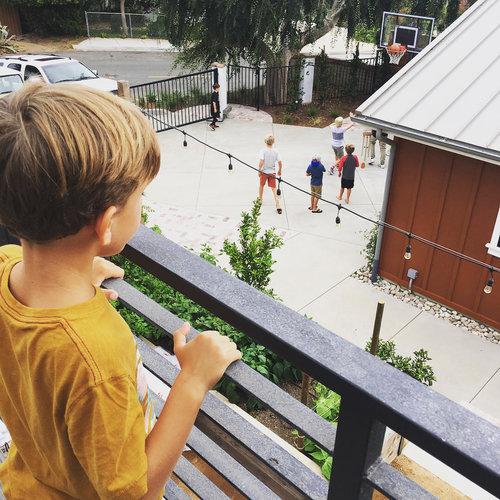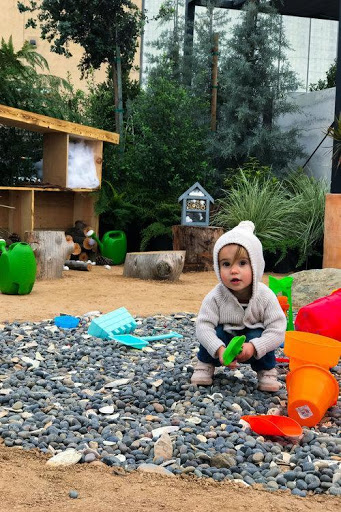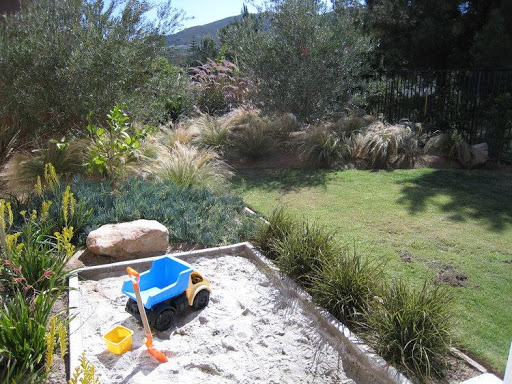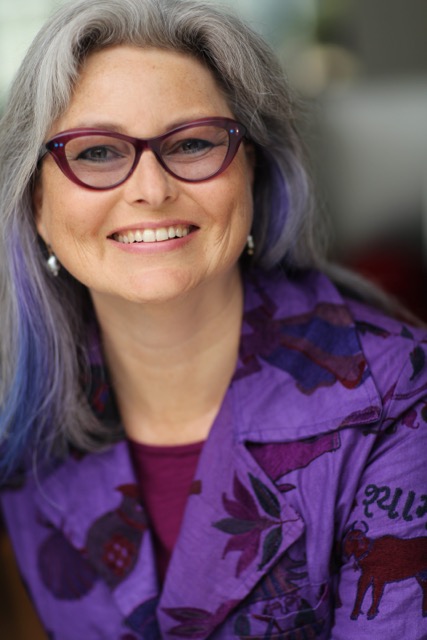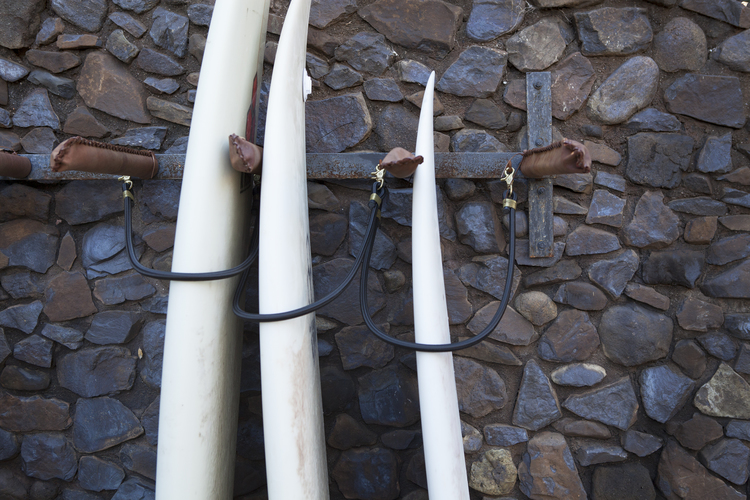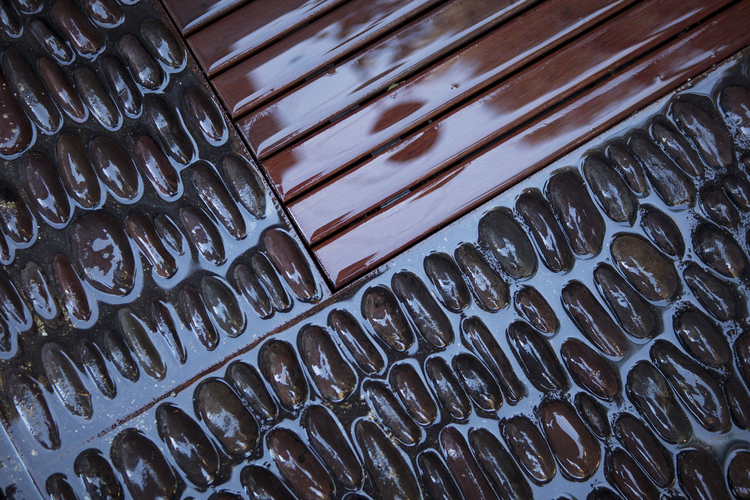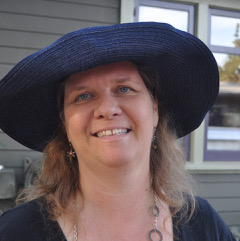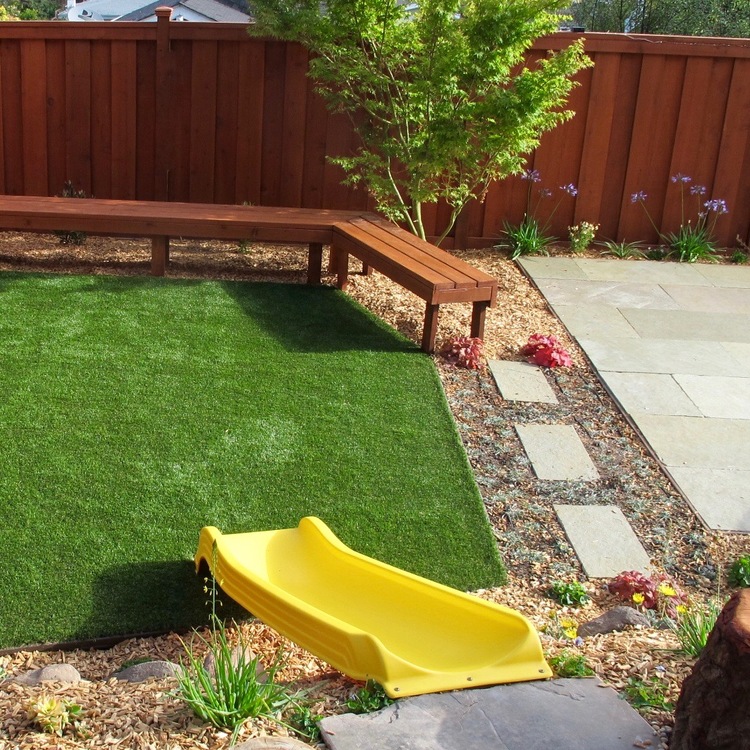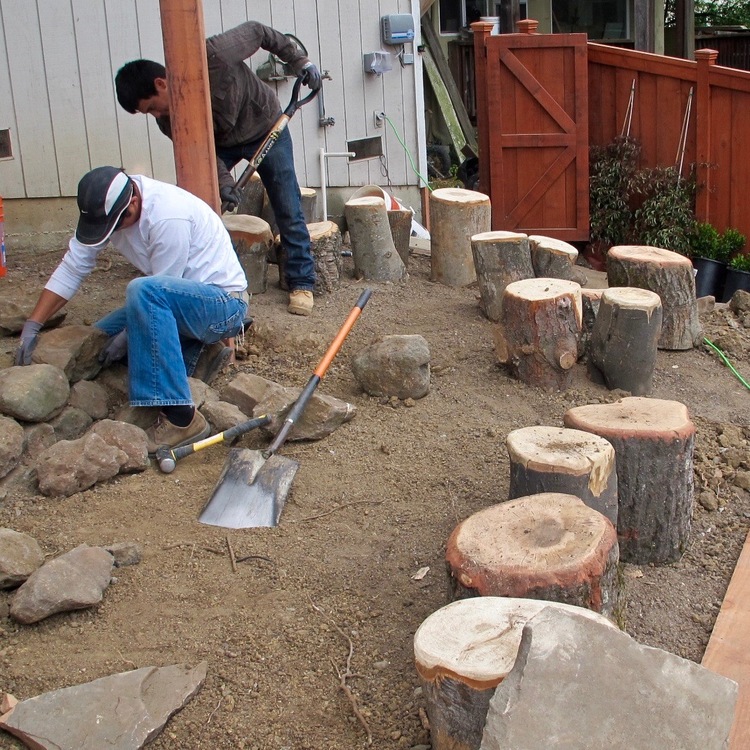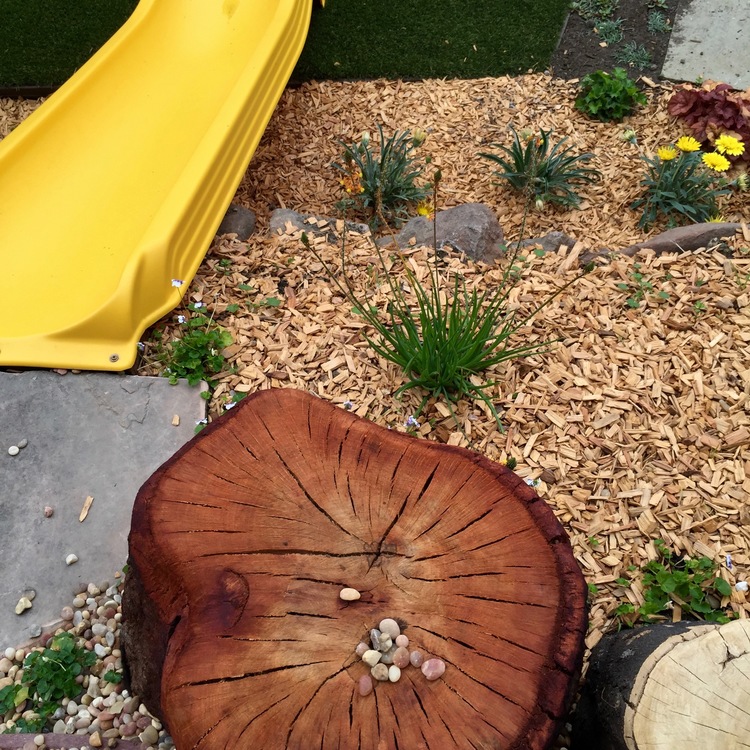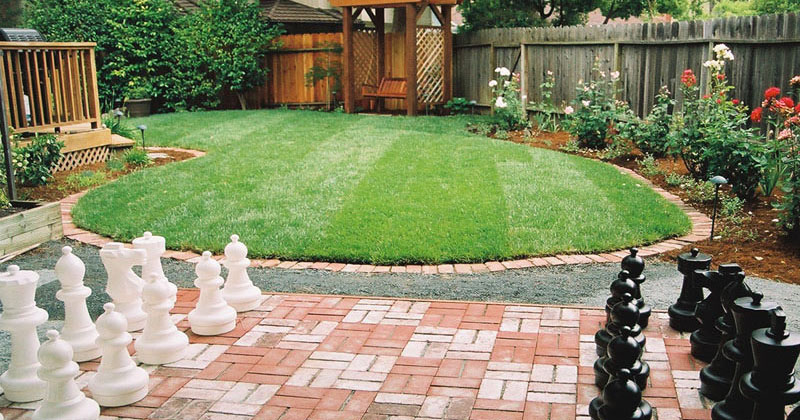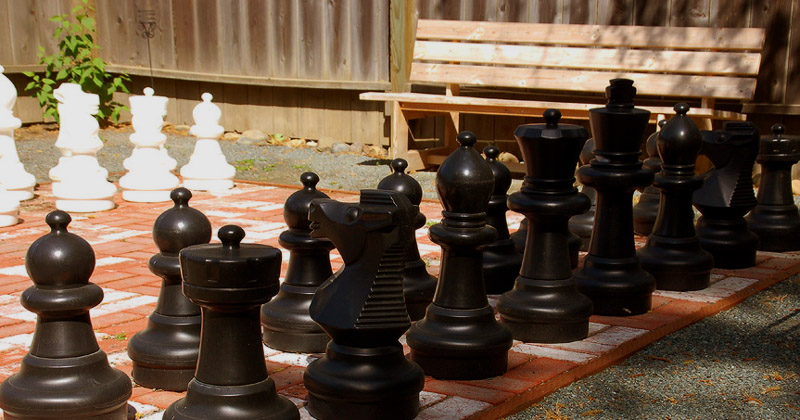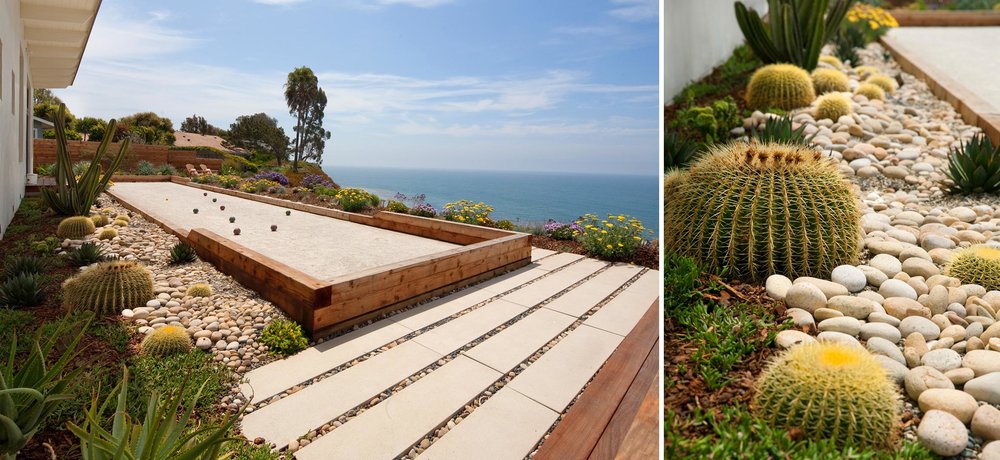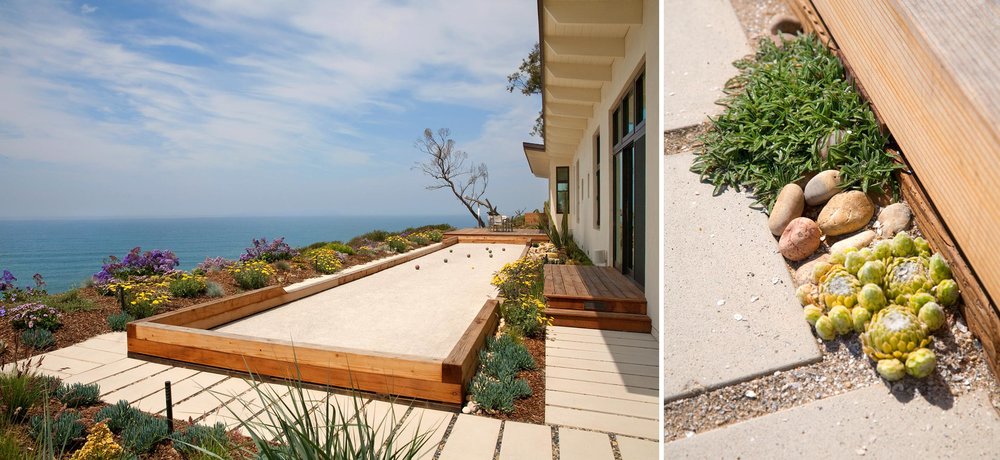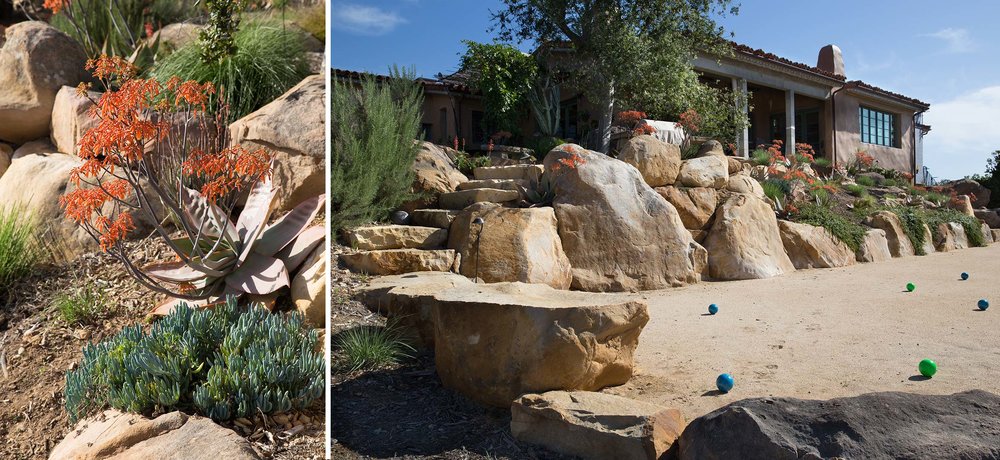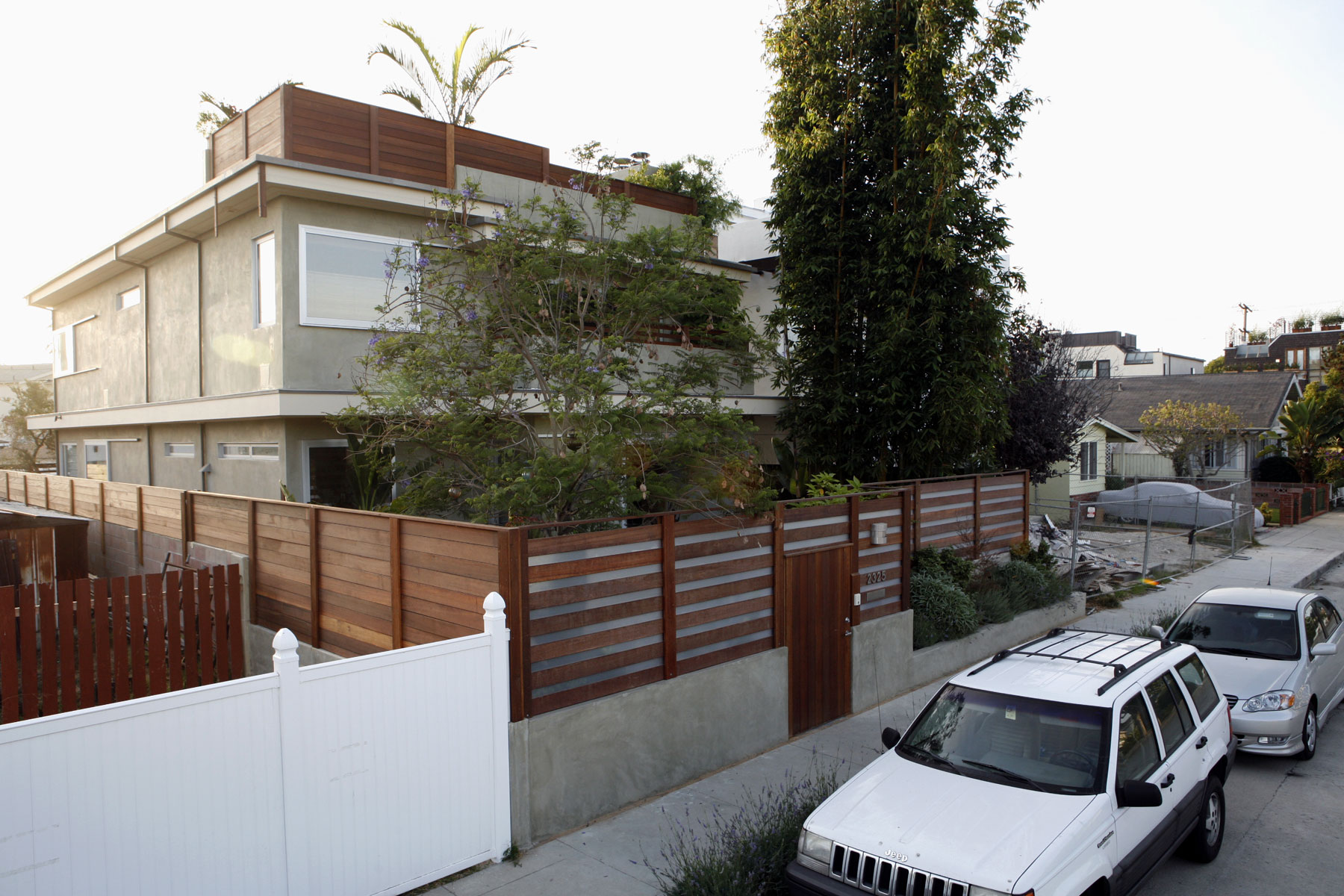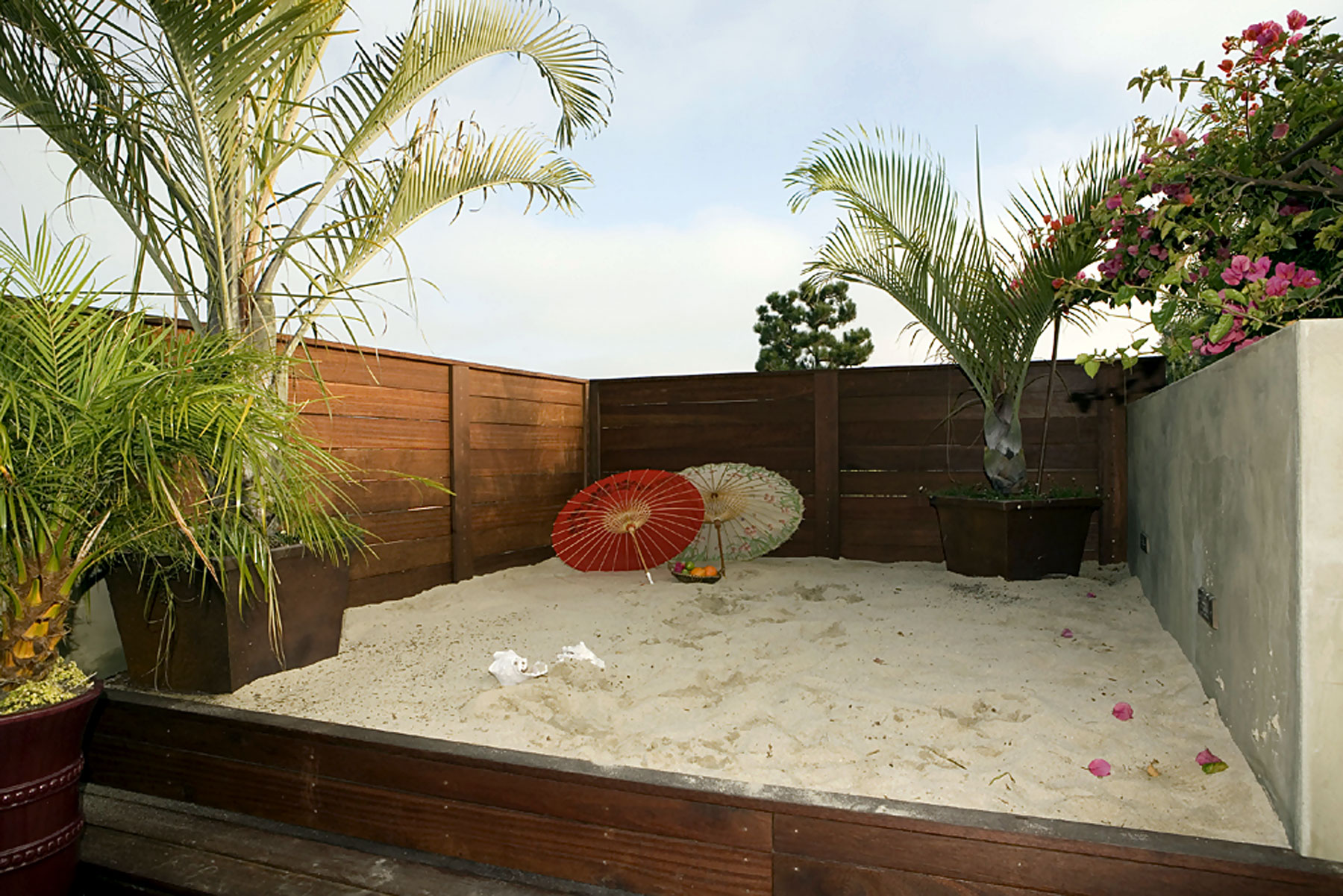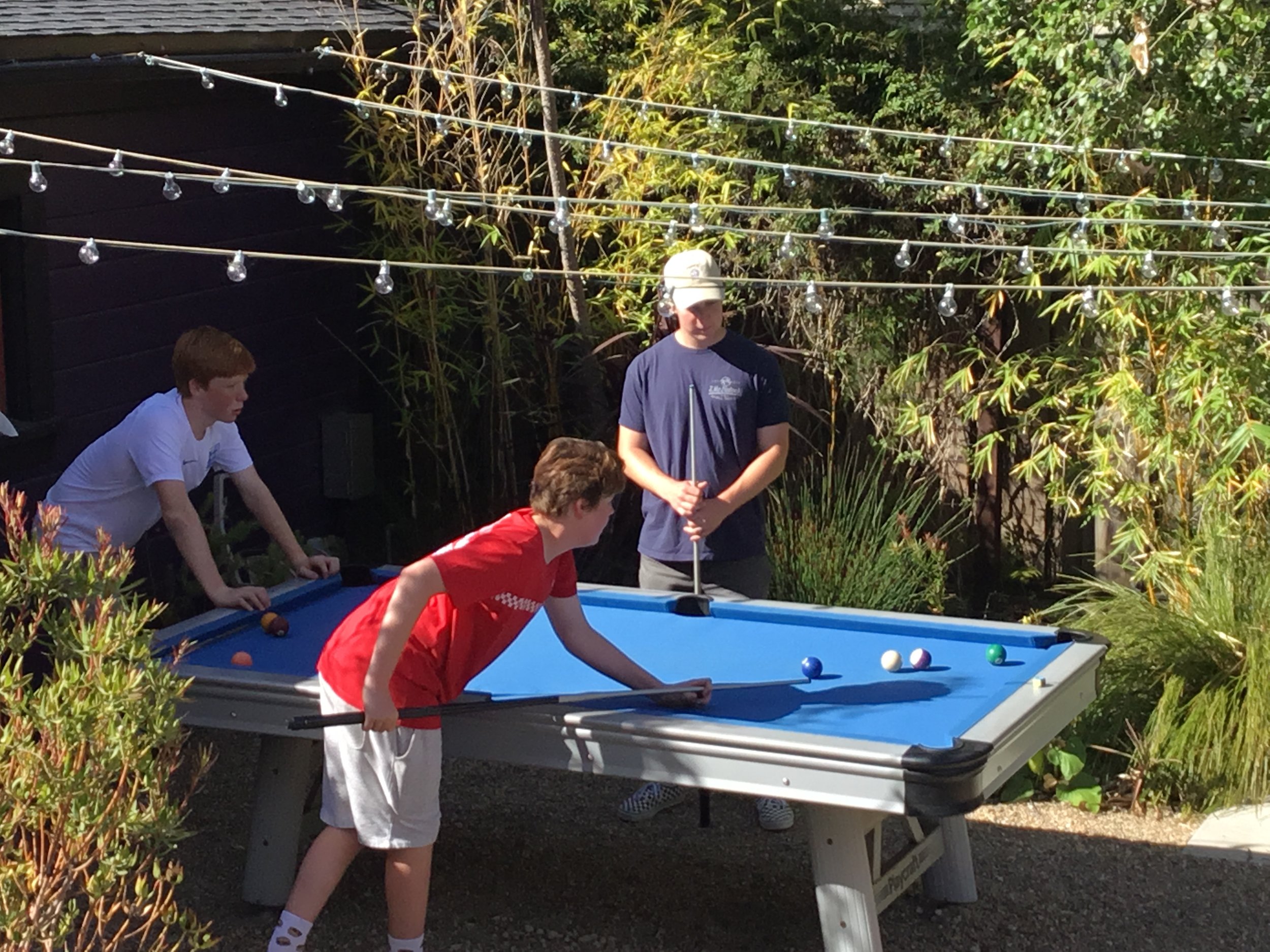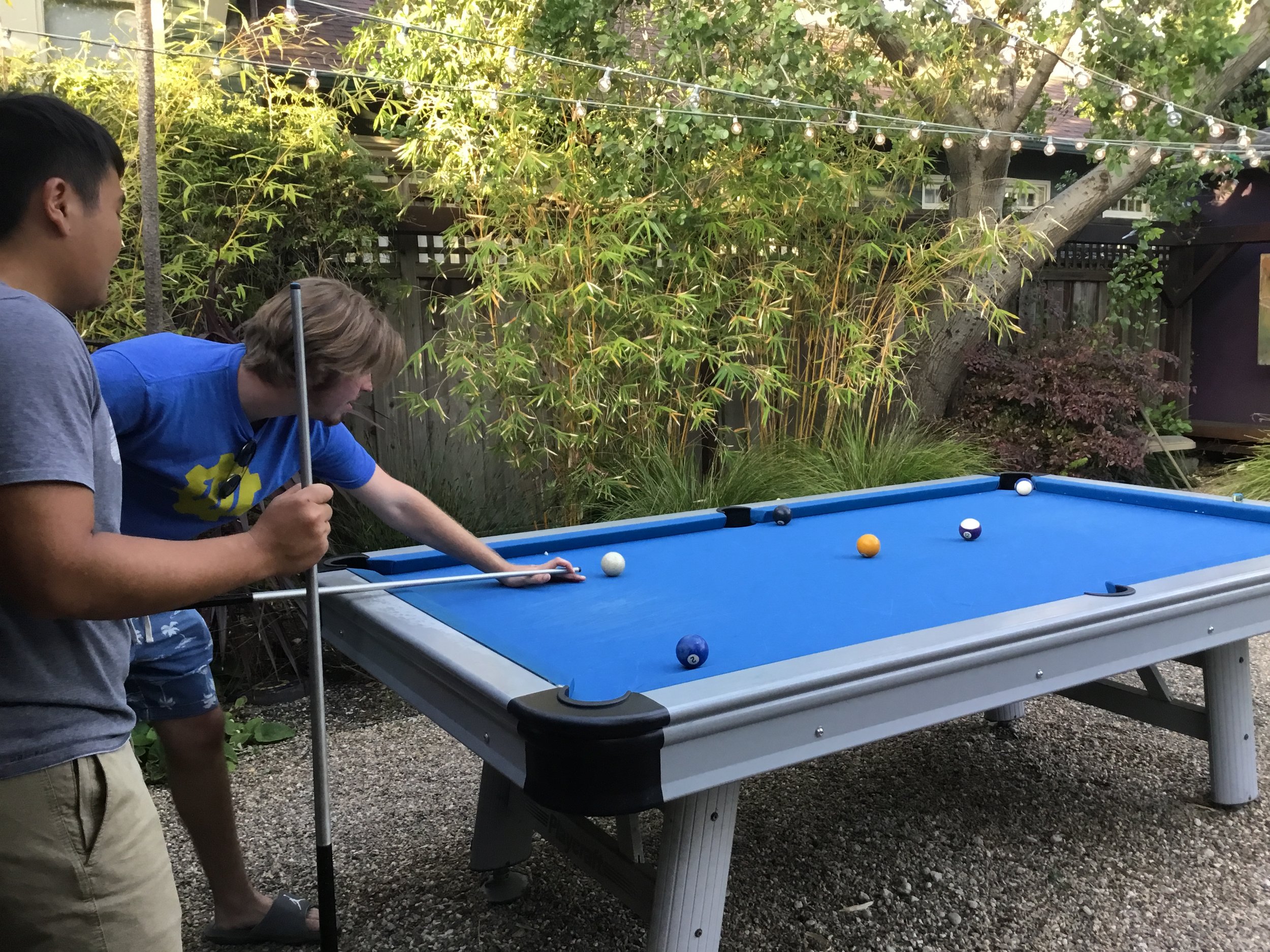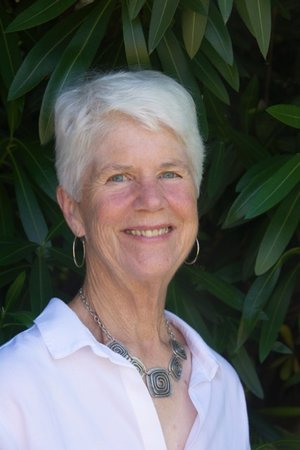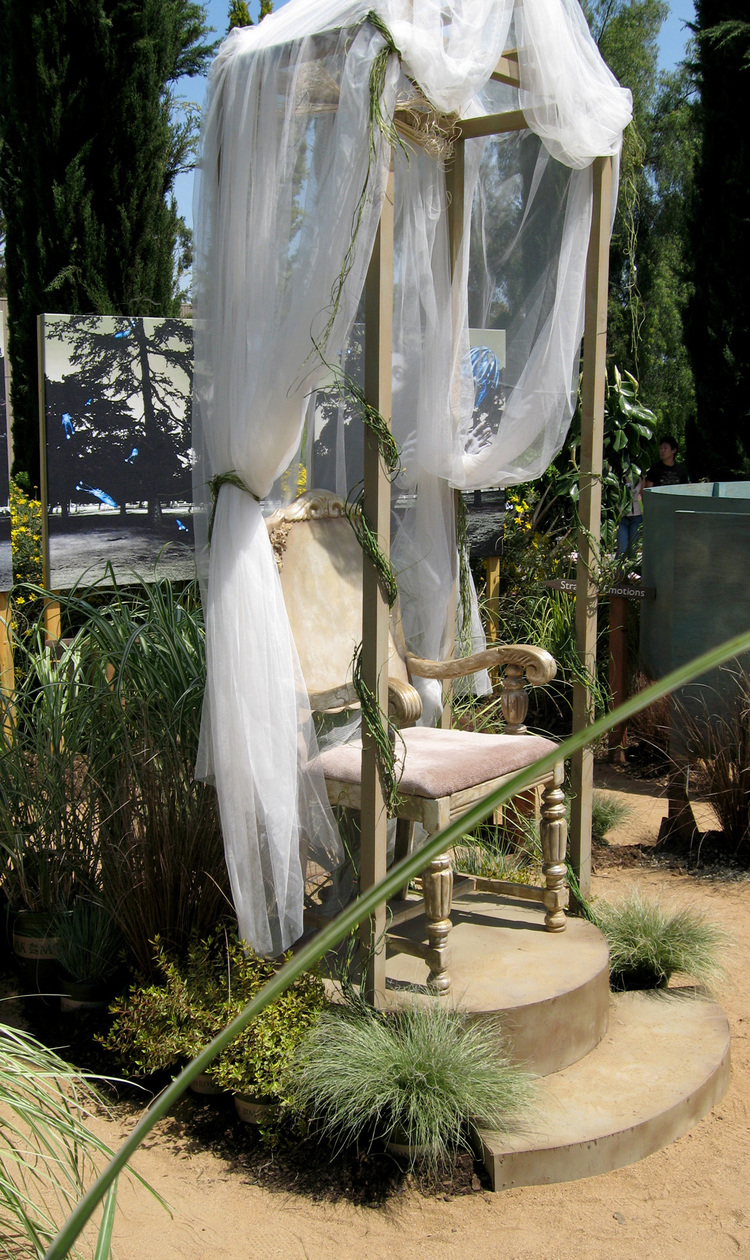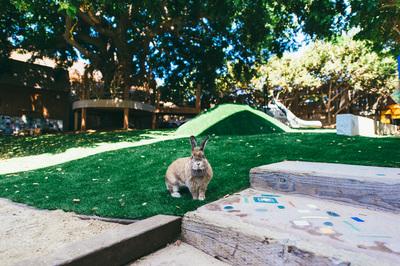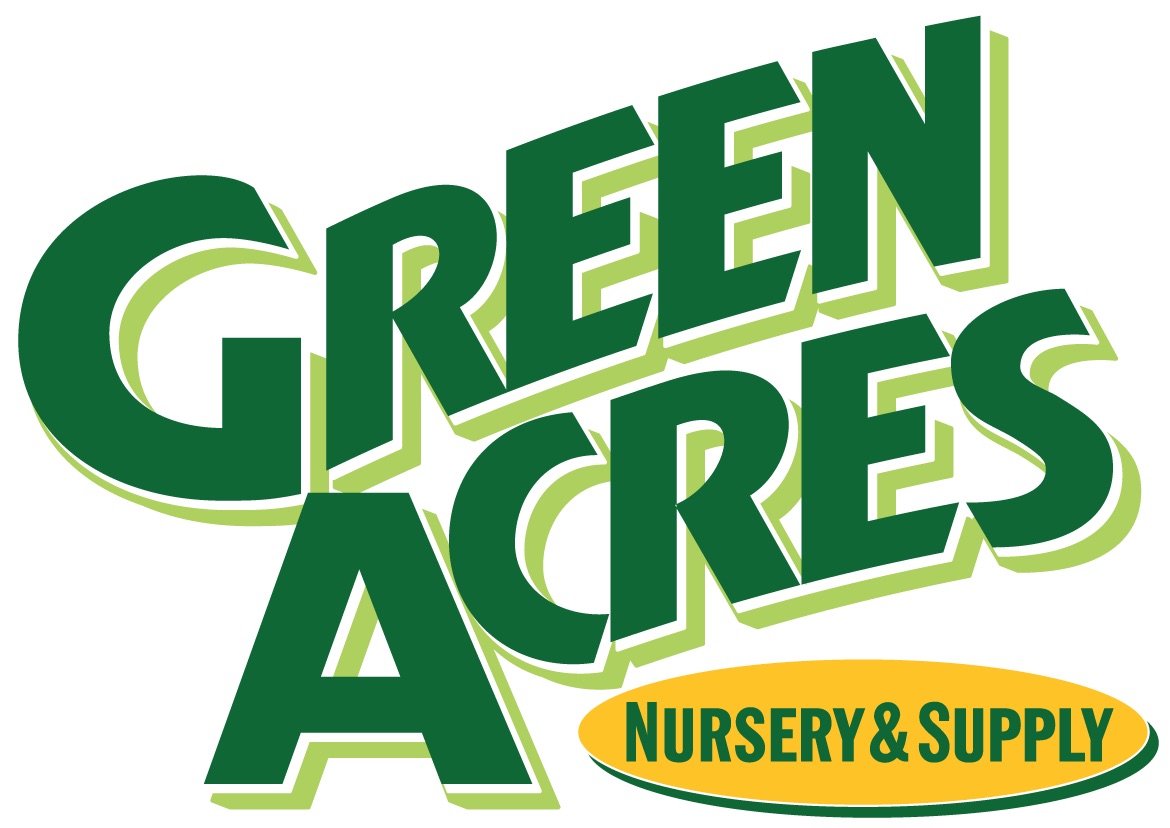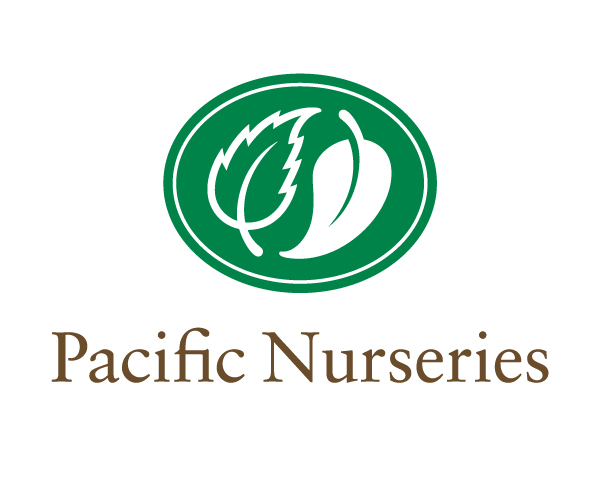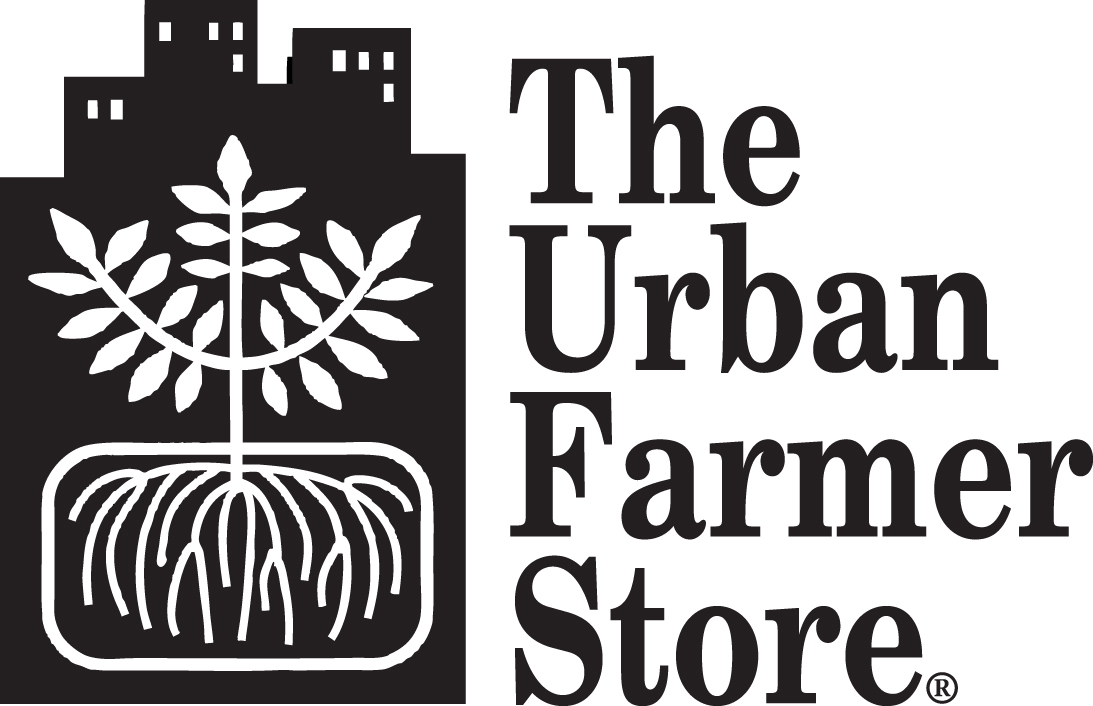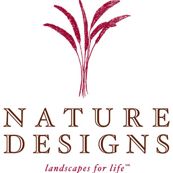FROM THE CHAPTER PRESIDENT
Francesca Corra, APLD
I am so happy to introduce this issue of California Landscape Design. I can’t tell you how many times I have heard clients say that they need to keep their lawn for the children to play. I actually don’t need to tell you since most certainly you have all heard this as many times yourselves. Remembering so many fun adventures as a child playing on the school yard tarmac, scampering through the woods at the bottom of the street, collecting pollywogs in newly formed mud puddles, creating “forts” out of leaves raked into the street, I know that children can create adventures on any surface.
As children, we were free to roam the neighborhood from the minute we started walking. I remember Mrs. Mulligan numerous times returning my sister’s bottle that she would drop in her yard as we ran through to play on the next street. It didn’t matter that every single summer we all managed to contract poison ivy. It never held us back! Those days are sadly long gone. Now almost every yard in California is fenced or walled. It is not safe to play in the street or to roam too far from home. This is why it is more important now than ever to create fun, stimulating, and natural environments for our children. I am excited to see all the brilliant ideas our designers have come up with. This issue is going to be a valuable tool when speaking to clients about spaces for their children.
The APLD Design Conference in Seattle is just around the corner. How exciting that is it completely sold out! I am so looking forward to seeing everyone, and happy to report that over thirty designers from our California chapter will be attending.
Happy Summer Everyone.
Ciao!
Francesca
CONTENTS
Simply scroll down to read the articles.
You may also click on the section titles below.
Letter from the Chapter President
Francesca Corra, APLD
TOOLS AND TIPS:
Designing Outdoor Play Spaces for Children by Laura Henry Kukulski
Encouraging Diverse Play by Annie Potter of Falling Waters Landscape
Edible Gardening with Children by Joan Bolton
Downloading Playfulness by Laura Morton, FAPLD
Thumbnail Designs: Playful Details
Nicholas Walker, FAPLD—Surfers’ Delight
Kathy Oberg—Felled Trees Get a New Life
Patricia St. John, FAPLD—Garden Chess
Margie Grace, APLD—Ocean Bluff Bocce
Margie Grace, APLD—Whimsical Retreat
Laura Morton, FAPLD—Rooftop Beach
Mary Fisher, FAPLD—Rack ‘Em Up
BOOK REVIEW:
Playborhood reviewed by Bernadette Ballics
PRODUCT REVIEW:
Cacoon reviewed by Shawn Maestretti
PLAYFUL LANDSCAPES AROUND THE STATE:
1. A Natural Playspace in Albany by Nina Mullen
2. Pumped Up in Saratoga by Cynthia Tanyan
3. An Architectural Collaboration in Echo Park by Stephanie Bartron, FAPLD
4. A Playful Slope in Oakland by Patricia St John, FAPLD
5. Family Farmhouse in Cardiff by Ryan Prange
6. Natural Living in Belmont by Kristen Rudger, APLD
7. Staycation Haven in San Carlos by Kristen Rudger, APLD
8. Edible Front Yard in Santa Barbara by Margie Grace, APLD
9. Whimsical Fun in Santa Cruz by Kathleen Shaeffer
10. A Playful Hillside in Cupertino by Julianne Adams Frizzell ASLA, FAPLD
11. A Family-Friendly Garden in Moraga by Mario Herrada
12. Canyon Family Playground in Los Angeles by Laura Morton, FAPLD
COMMUNITY CONNECTIONS:
The Nature of Play Experiential Garden at The Los Angeles County Arboretum & Botanic Garden by Ketti Kupper
Hanna Fenichel Garden Classroom by Anne-Emilie Gold
Therapeutic Garden Learning by Arleen Ferrara
What’s Happening with APLD Around California
Welcome New Members
How to Make a Good Lighting Job Great
Photo courtesy of Laura Morton, FAPLD.
TOOLS AND TIPS:
Designing Outdoor Play Spaces for Children
by Laura Henry Kukulski
Terralinda Design, Oakland, CA
When designing a residential garden for a family with young children, we have amazing opportunities to create space for children to play.
Play space can be integrated seamlessly into any landscape design. Outdoor play for children is not just about large lawns or big expensive play structures. In many places around California, lawns are not a possibility, as well as not advisable, and many people do not have space for large structures. But that is fine! There are so many other ways that children play! A good play space provides room for physical, social, dramatic, cognitive play, and can invite many kinds of spontaneous activity.
It can be hard to know what exactly a child will engage and play with, especially if you have only met them once or twice. You should get some basic information about a child’s personality from the parents. Ask questions like: is your child more prone to active play or imaginative play? Do they seek out sensory input, have big energy, or like to create with their hands, or do they seek out quiet spaces for contemplative play?
Aim to create spontaneous, organic play for kids by including natural elements that allow for undirected and open-ended play.
Photo courtesy of Laura Henry Kukulski.
Encouraging Diverse Play
by Annie Potter, Associate Designer at Falling Waters Landscape
At Falling Waters, we praise all things having to do with the landscape. This extends into our belief that the outdoor experiences of a child's day are vital to their mental, physical, and social growth. Children learn best when all of their senses are activated. Unlike adults, they cannot sit in a two hour lecture given solely by word of mouth. In order to imprint a lesson into a child's mind, information has to be presented to them as something worth remembering. By allowing them to physically engage in the subject matter and personally see and feel it in real life, children will get excited for the lesson and their brain will absorb it more fully. For instance, showing a picture of the photosynthesis process is nothing compared to actually seeing it happen. In order to keep children engaged and constantly growing their breadth of knowledge, their interaction with their natural environment should be a key priority during the day.
Photos courtesy of Ryan Prange, Principal at Falling Waters Landscape.
EDIBLE GARDENING WITH CHILDREN
by Joan Bolton
Santa Barbara Garden Design, Goleta, CA
School's out and there's no better time to enlist your kids to grow fresh edibles. Many summer crops grow fast and yield bounty that children like to eat. Start your kids playing in the dirt early, and they'll develop an appreciation for home-grown food and healthy habits for life.
If you don't have children, gather your neighbors' kids instead. Or simply vow to rediscover your inner child by taking time to view your garden with wide-eyed wonder, kneeling down to breathe in the scents and to inspect your emerging edibles from a ground-level perspective.
With the popularity of school gardens, some parents may even face a bit of role reversal, with their kids being the ones pestering them to plant veggies. Regardless of the youngsters you round up, don't be intimidated if they seem to have more gardening experience than you do. The following is a quick-start guide, no matter who's just beginning to dig in the dirt.
Photo courtesy of Margie Grace, APLD.
DOWNLOADING WONDER
by Laura Morton, FAPLD
Laura Morton Design, West Hollywood, CA
Call me old-fashioned, but what happened to making mud pies and finding crickets as a way for kids to pass time?
I’ve always felt my job, or at least the subtext in my work as landscape designer, should awaken some childlike wonder and comfort with the natural world—for children and adults alike. Biology and architecture: it’s our science, and the way we design can make discovery fascinating.
My most memorable childhood adventures don’t include play sets so much but being told to "go play outside!" and then occurred the meander, testing of boundaries, and accidental discoveries like a birds nest, bug, or hiding place. The natural world offers seasonal changes that help subtly understand the passage of time, set anticipation, and help say goodbye. And there are the raw materials for creative play—leaves, soil, sticks, and seedpods that become building blocks and teach balance. Additionally, gardens with berry patches, aromatic herbs, chickens, and seasonal fruits can connect a child to world of wide-eyed delight.
Thumbnail Designs: PLAYFUL Details
By Nicholas Walker, FAPLD
Campion Walker Landscapes, Topanga, CA
SURFERS’ DELIGHT
by Kathy Oberg
Fairy Yardmother, Los Angeles, CA
FELLED TREES GET A NEW LIFE
If you like a more rustic look, and you love the idea of recycling, you can re-use stumps and tree trunks to create a lovely natural play space. Kids 2 to 5 years old love balancing on short walls, logs or stumps.
by Patricia St. John, FAPLD
St. John Landscapes, Berkeley, CA
GARDEN CHESS
by Margie Grace, APLD
Grace Design Associates, Inc., Santa Barbara, CA
OCEAN BLUFF BOCCE
The ocean bluff side of the house is a narrow strip designed and installed with strictly low impact uses. A cantilevered deck, native plants, dry-laid pavers, and a bocce court bring the living outside. A small “beach” adjacent to the bocce court provides a place to run your toes through the sand while overlooking the white water below.
Also by Margie Grace, APLD
WHIMSICAL RETREAT
This young family wanted a place for play, adventure, and outdoor living – spaces to foster curiosity and fun, nurture their love of nature and enjoy the company of family and friends. Wishlist items included: shady sitting areas, play lawns, two outdoor showers, casual outdoor cooking and dining, fountains, a bocce court, and landscape lighting. Entertaining, meditating, or playing pirates, the landscape allows for pure satisfaction and enjoyment, as life was meant to be.
by Laura Morton, FAPLD
Laura Morton Design, Los Angeles, CA
ROOFTOP BEACH
On the rooftop of this project, we installed a virtual “Venice Beach” for the kids—a large, deep sandbox, with an adjacent sunflower head shower to cool down.
by Mary Fisher, FAPLD
Mary Fisher Garden Design, Alameda, CA
RACK ‘EM UP
I originally designed this back yard to be a flexible space for the family of four. The gravel area was big enough to be a fire pit area or perhaps hold a ping pong table. A few years after installation, the homeowner, Joanna Bianchi, decided on an outdoor pool table. This was an instant hit with their two teenage boys and all their friends.
BOOK REVIEW:
PLAYBORHOOD BY MIKE LANZA
Reviewed by Bernadette Balics
Ecological Landscape Design, Davis, CA
I’m a big fan of building real-life community, and believe landscape designers can do so even while designing single family residential projects. This book shows one approach to doing just that.
The book, written by a father of three children, begins with a manifesto, a vision of a neighborhood block that allows kids to shape their own play time: ‘I want my kids to play outside with other neighborhood kids every day…’ I want them to create their own games and rules… I want them to make lasting physical artifacts that show the world that this is their place…
PRODUCT REVIEW:
Metamorphosis in the Garden
by Shawn Maestretti Shawn Maestretti Garden Architecture, Altadena, CA
In 2015 I visited the Chelsea Flower Show for the first time and discovered the Cacoon hammock. I have been waiting for the day I got to purchase one and during our 2019 visit, my wish came true. Now that we own a house with a large Coast Live Oak tree, there is a place for this wonderfully playful element in our garden.
This perfectly executed line of outdoor furniture was inspired Weaver Birds and their tiny hanging nests in Mexico. The designs combine the beauty of steam-bent wood with tensile fabric technology, embracing the traditions of boat building, sail-making and rope work, presented with a contemporary twist.
I purchased the Domo for its spacious enclosure so we could enjoy father-son time, and of course Papa and Daddy time, while being at one with nature. We look forward to backyard camping, napping, reading time and much more. Once the neighborhood children find out about this it will be non-stop joy.
Shawn Maestretti Garden Architecture is officially an affiliate of Cacoon. See all that there is to bring play and relaxation into your garden spaces. Prepare yourself for transformation and order yours today by clicking their logo below. Use promo code: cacoon.
Photo courtesy of Joel Lichtenwalter/Grow Outdoor Design.
PLaYFUL Landscapes around the State
Click HERE to view this article in full.
by Nina Mullen
Mullen Designs, Albany, CA
A NATURAL PLAYSPACE IN ALBANY
When Virginia and Tom McKone first met with us to design a new front and back landscape after a major expansion of their small Albany home, it was clear that creating a place for exploration and play for their young friends who visit regularly was a key element. The front already had a bench built into the retaining wall under a lemon tree to welcome passersby to sit a moment or pick a lemon to enjoy. The back was a slope of dirt and weeds above a new dining patio calling for transformation.
Photo courtesy of Nina Mullen.
by Cynthia Tanyan
Mozaic Landscapes, Sunol, CA
PUMPED UP IN SARATOGA
What to do with a long narrow backyard for a father and his two sons who love to bicycle?
Why, build a pump track, of course. A pump track is a circuitous route with measured built in berms and rolling mini hills that allow the rider to ride without pedaling. By skillfully using momentum and a “pump” action with the arms the rider is able to pick up speed with quite a workout.
Photo courtesy of Cynthia Tanyan.
by Stephanie Bartron, FAPLD
sb garden design llc, Los Angeles, CA
AN ARCHITECTURAL COLLABORATION IN ECHO PARK
Stephanie’s client, architect Barbara Bestor transformed this house from a tarpaper shack into a contemporary architecture showpiece. Stephanie Bartron designed a garden to match, extending the architectural program into the backyard with a large outdoor living/dining room. At the front edge of the property, between the fence and the pergola, lies a secret children’s garden with sandbox, climbing rock, swings and vegetable beds.
Photo courtesy of Stephanie Bartron, FAPLD.
by Patricia St. John, FAPLD
St. John Landscapes, Berkeley, CA
A PLAYFUL SLOPE IN OAKLAND
Mix together a sloping front yard and a two-year-old and you get a bright red slide running down a low water-use tropical garden. On a busy corner in Oakland, the two-year-old has a safe place to play, and on the opposite side of the front pathway, the dogs have a place to play also.
Photo courtesy of Jude Parkinson Morgan.
by Ryan Prange
Falling Waters Landscape, Encinitas, CA
FAMILY FARMHOUSE IN CARDIFF
If something in your life does not give you joy; whether that is clothing, accessories, relationships, or your landscape, then it is not worth having clutter your mind. At Falling Waters we take the plunge into what a client really wants and needs within the landscape and we discard the rest: a Kondo methodology.
We used this process with the Oxford Ave project a Farmhouse in Cardiff; the homeowners had a decent amount of space to fill and it was our challenge to design it intentionally.
Photo courtesy of Falling Waters Landscape Inc.
by Kristen Rudger, APLD
Kristen Rudger Landscape Design, Belmont, CA
NATURAL LIVING IN BELMONT
The homeowners loved the natural feel of their property which is on a moderate down sloping lot in Belmont. A large Coast Live Oak at the center of the backyard space provided a beautiful focal point. The main objective for the homeowners was to make the site more useable and safe for their young children to play.
Photo courtesy of Jude Parkinson Morgan.
Also by Kristen Rudger, APLD
STAYCATION HAVEN IN SAN CARLOS
The backyard had only 15’ deep patio and some artificial turf framed by a 5’ high concrete retaining wall. There was an existing very steep and unsafe stairway which let to a large up sloping hill. Our objective was to create a safe and comfortable connection between the two spaces and to make the hill more usable. We terraced the hill into 3 sections. The first for a vegetable and butterfly garden, the second for lawn, hot tub and fire pit and the third terrace includes a playhouse, climbing logs, dry creek bed and a deck which offers a spectacular view of the Bay.
Photo courtesy of Jude Parkinson Morgan.
by Margie Grace, APLD
Grace Design Associates, Inc., Santa Barbara, CA
EDIBLE FRONT YARD IN SANTA BARBARA
The backyard had only 15’ deep patio and some artificial turf framed by a 5’ high concrete retaining wall. There was an existing very steep and unsafe stairway which let to a large up sloping hill. Our objective was to create a safe and comfortable connection between the two spaces and to make the hill more usable. We terraced the hill into 3 sections. The first for a vegetable and butterfly garden, the second for lawn, hot tub and fire pit and the third terrace includes a playhouse, climbing logs, dry creek bed and a deck which offers a spectacular view of the Bay.
Photo courtesy of Holly Lepere.
by Kathleen Shaeffer
Kathleen Shaeffer Design
Santa Cruz, CA
WHIMSICAL FUN IN SANTA CRUZ
This project was part of an overall home renovation. The owners wanted the garden to reflect, and be an extension of, the colorful and highly personalized interior of their home. They wanted an expansive space for entertaining both adults and children. The patio accommodates outdoor dining and relaxing and provides a fun place for their young daughter and her friends to play – the artificial turf spiral wraps around a covered sandbox. Along the back of the property another patio was created next to a creek that runs yearlong.
Photo courtesy of Kathleen Shaeffer.
by Julianne Adams Frizzell, ASLA, FAPLD
Julianne Adams Frizzell - Landscape Architect, Palo Alto, CA
A PLAYFUL HILLSIDE IN CUPERTINO
The hillside gardens of this property were destroyed during an extensive remodel. Only a lone Redwood at the front of the property and a massive Live Oak on the hillside were saved. The clients wanted a modern look to complement the updated architecture. There is a seat wall and sand box in one of the side yards that can be turned into a patio area after the children are grown. A slide down the hill under the big Oak is a feature on the other side of the house.
Photo courtesy of Julianne Adams Frizzell, ASLA, FAPLD.
by Mario Herrada
Zacate Landscape Design, San Francisco, CA
A FAMILY-FRIENDLY GARDEN IN MORAGA
This family friendly garden occupies three levels. The highest level was designed around a wood play structure. Decomposed Granite, with a stabilizer, circles the play mulch, allowing the children a place to ride their pedal cars. A circular Blue Stone Patio is the perfect place for adults to gather and watch over the children.
Photo courtesy of Mario Herrada.
by Laura Morton, FAPLD
Laura Morton Design, West Hollywood, CA
CANYON FAMILY PLAYGROUND IN LOS ANGELES
Sited in the canyon and surrounded by giant trees, this shady property had a tendency to stay moist and muddy. Improving the entry and walkway to this contemporary home in the canyon was essential.
The new design called for laying the existing small slate flagstone into larger raised pads of grey-colored concrete for a sound pathway to the front door. They were poured in place with impressions of sycamore leaves. Woodland plantings in green and burgundy hues included oak leaf hydrangea and Japanese maple; and succulents provide year-round beauty.
Photo courtesy of Laura Morton, FAPLD.
COMMUNITY CONNECTIONS:
The Nature of Play Experiential Garden
at The Los Angeles County Arboretum & Botanic Garden
by Ketti Kupper
Conscious Living Landscapes, Altadena, CA
“The Gate of Now”
This experiential garden was created with a sense of enchantment for people of all ages at the Los Angeles County Arboretum in April 2007. In this 30’x30’ art installation, visitors moved through ten distinctive interactive features designed to bring greater awareness in one’s own life journey. People sat at the “Table of Transition” to write their notes for “The Wall of Wishes”. Here are a few wishes people put on the wall: “I wish no one got sick”, “I wish that my tortoise will stay healthy”, “I wish to be creative every day”, “I wish to live with cancer for 15 years okay”, “I wish for more love in everyone’s hearts”, “I wish for personal calmness”, “I wish the world was like this garden”.
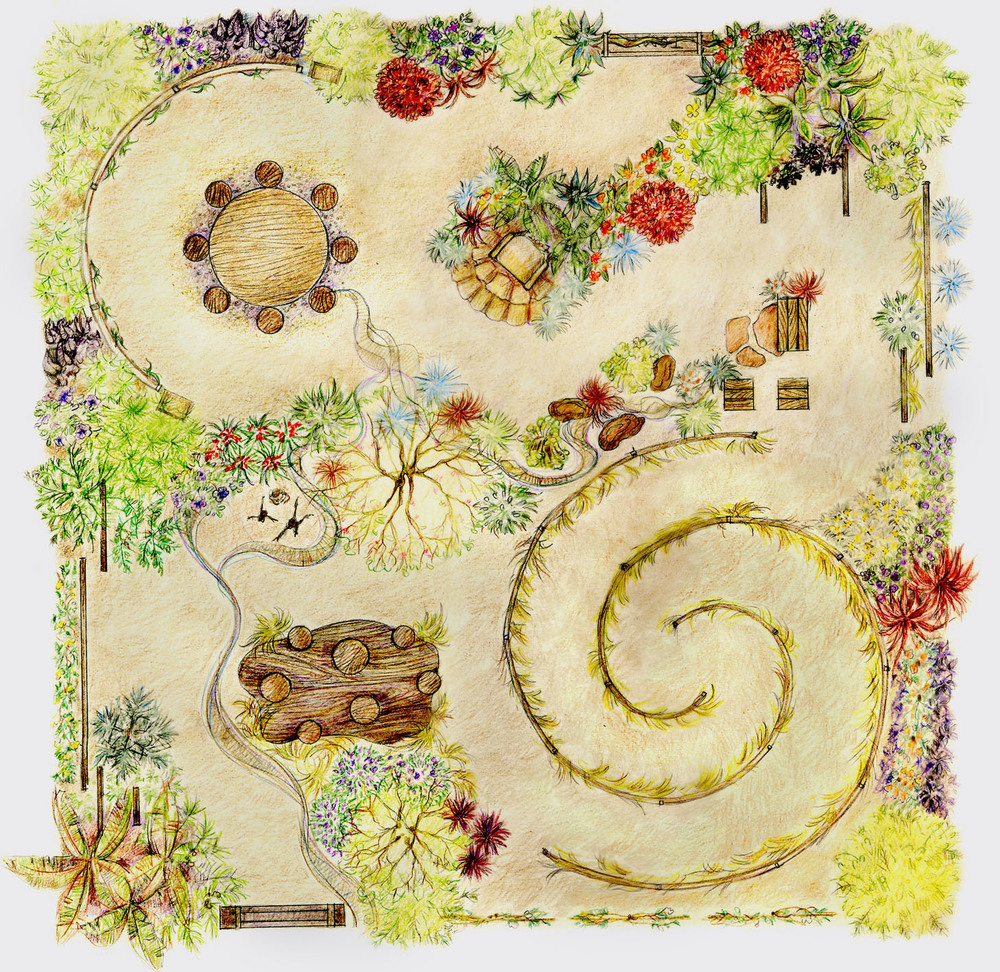
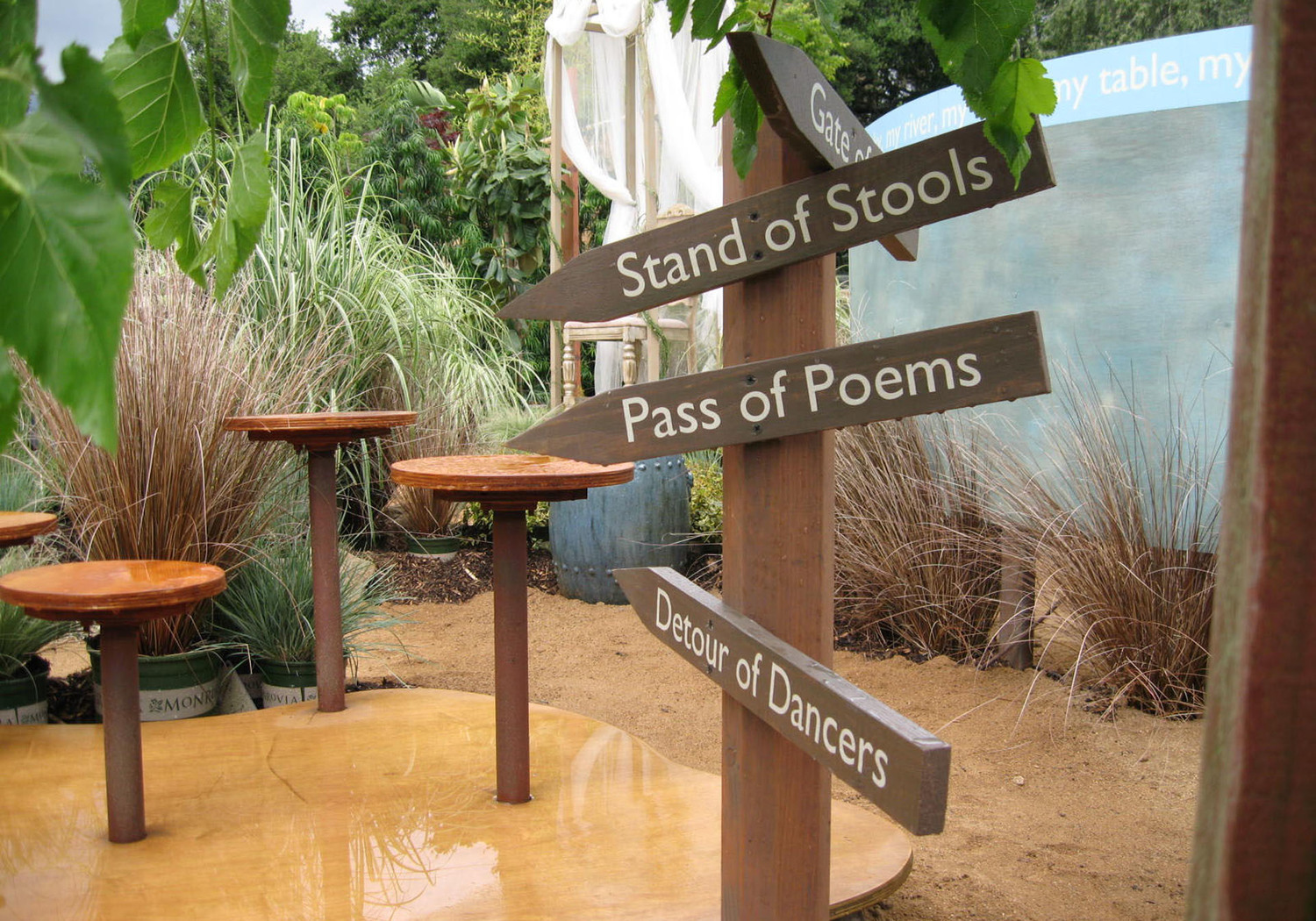
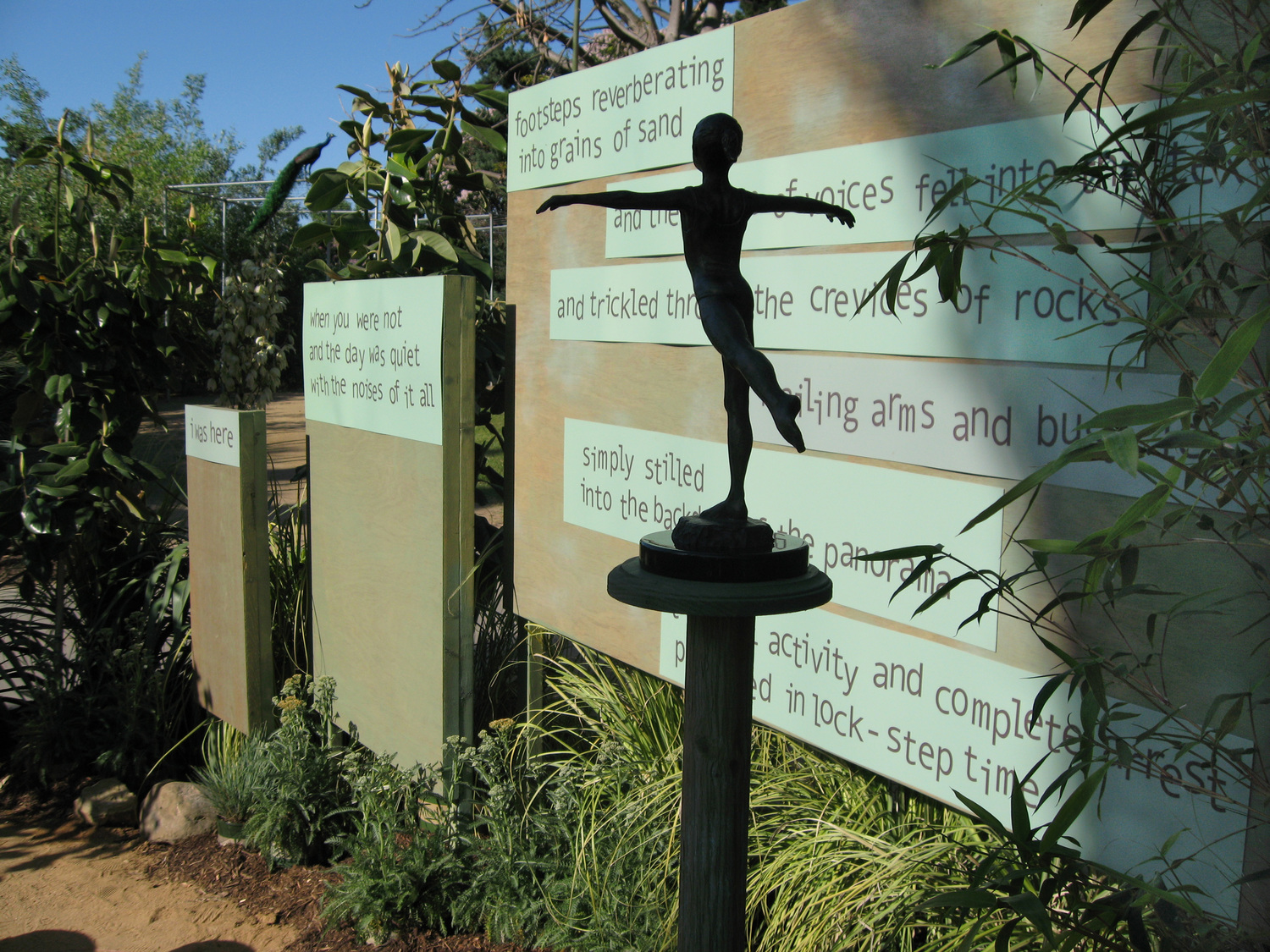
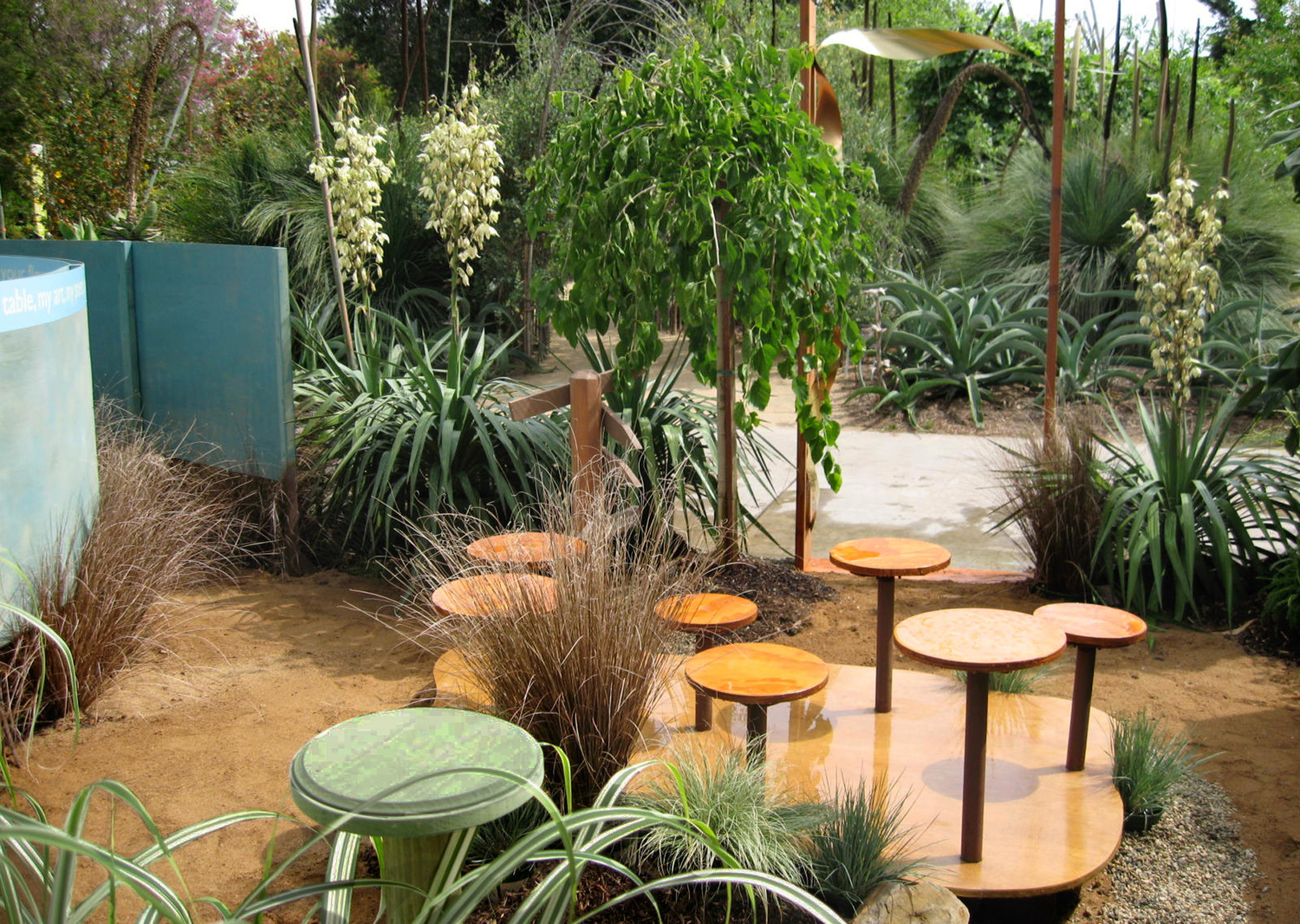

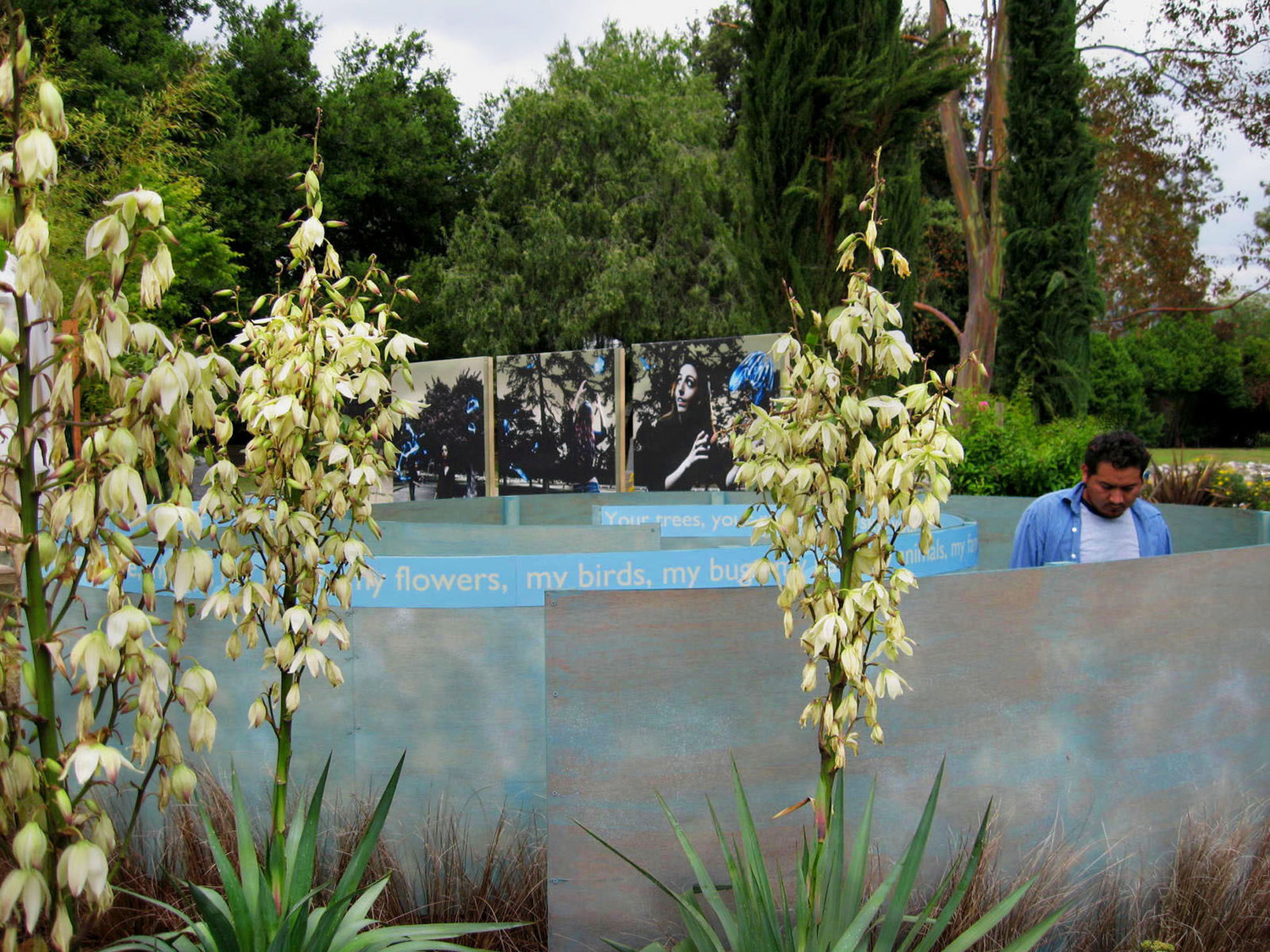
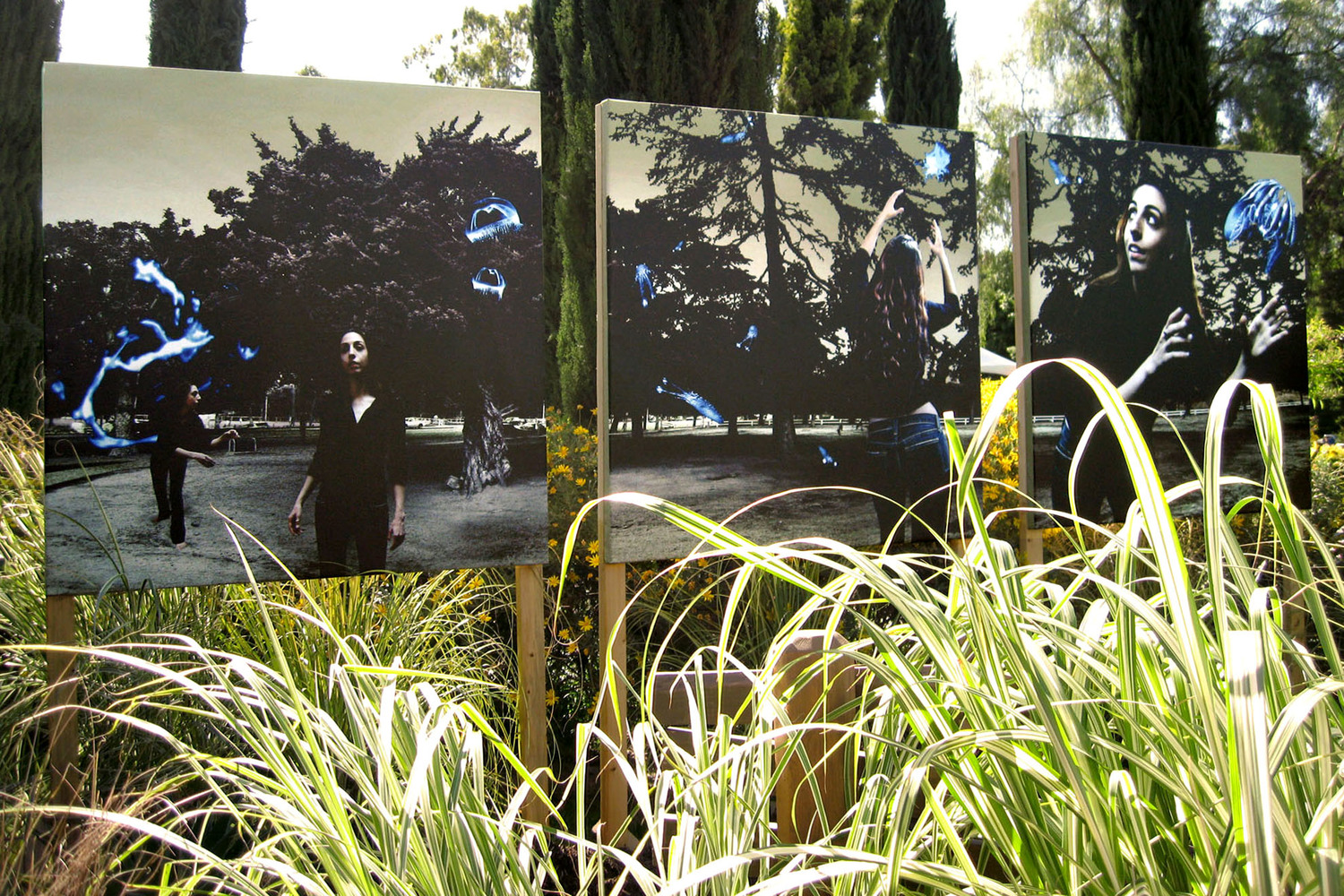
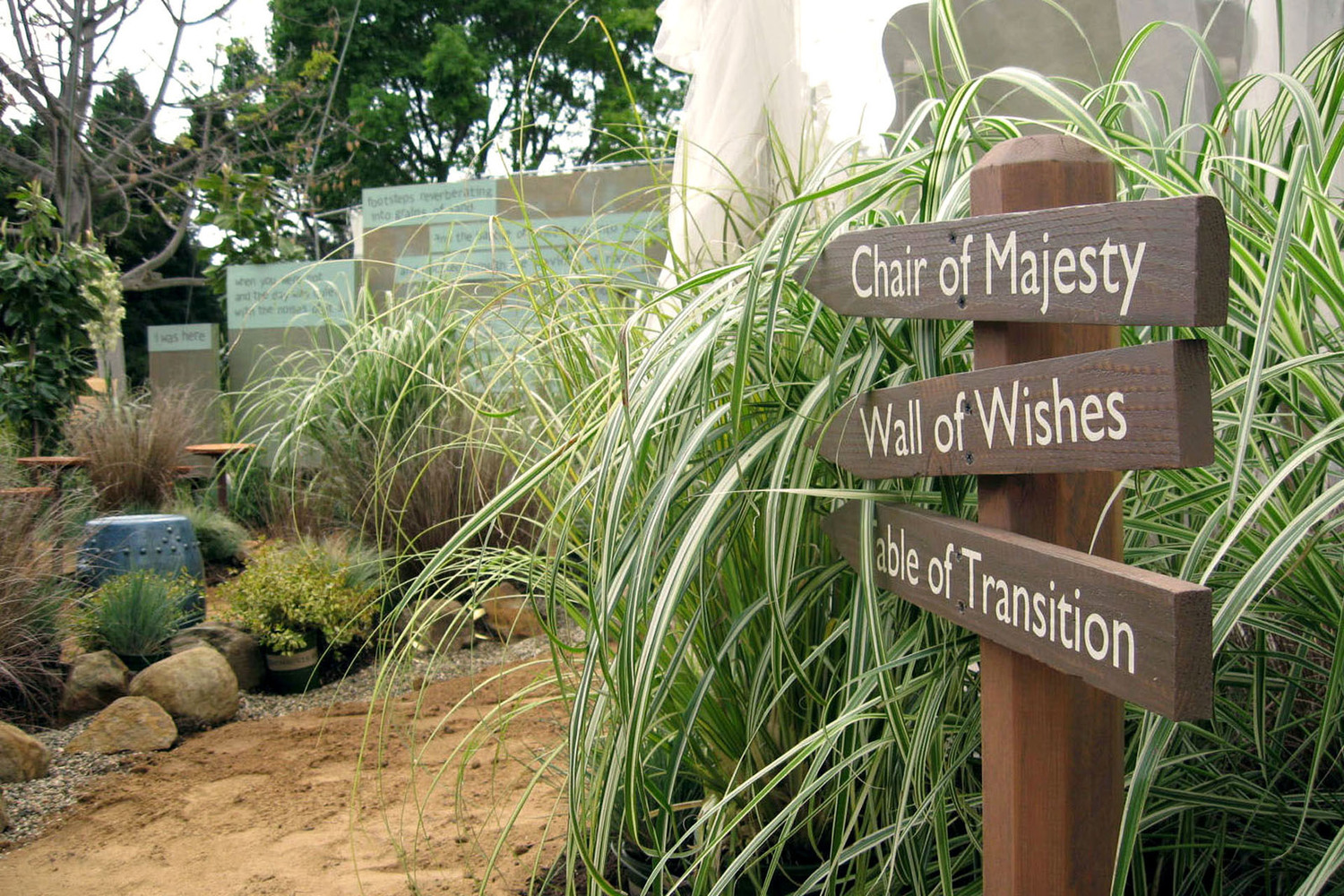
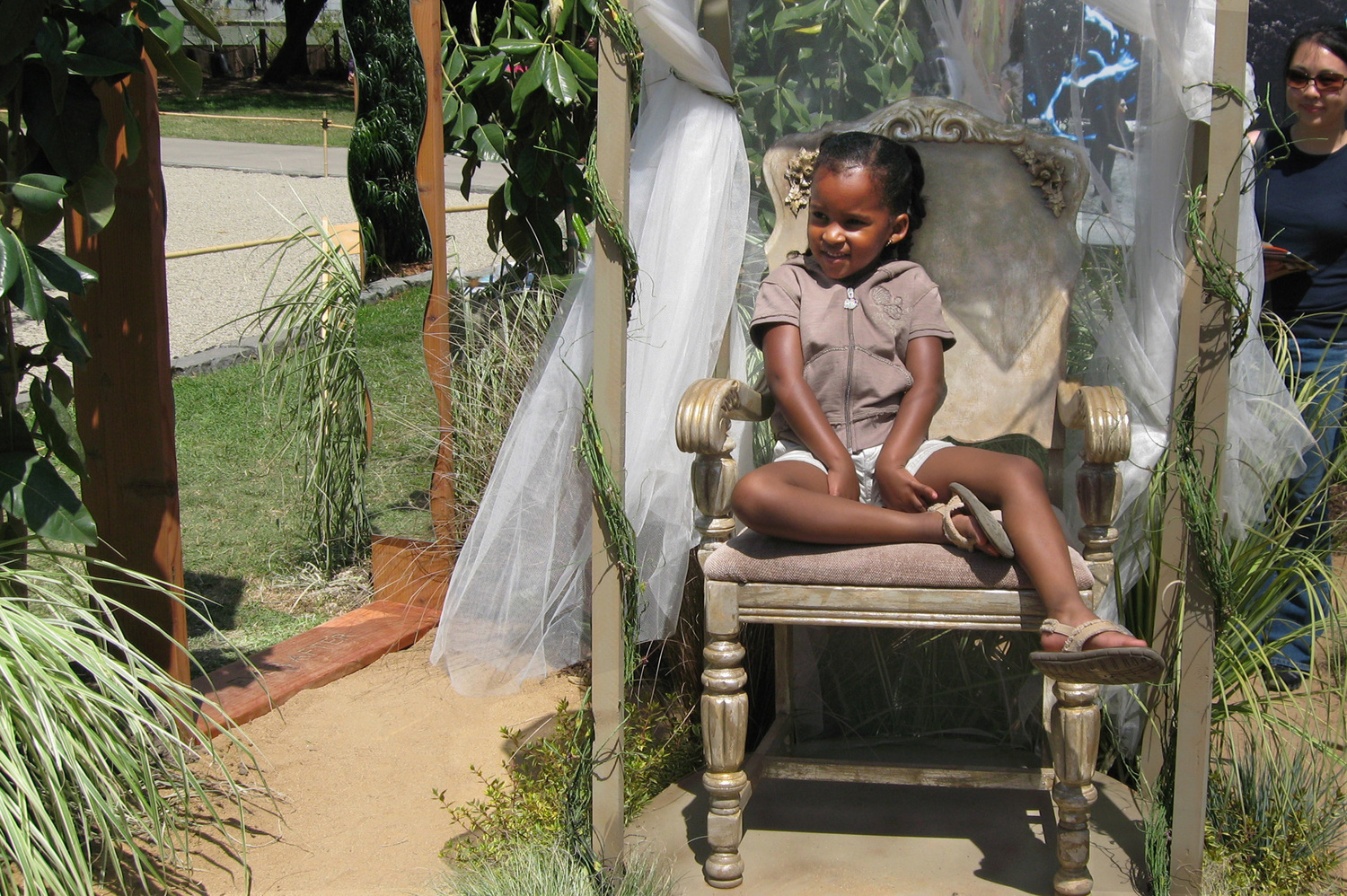
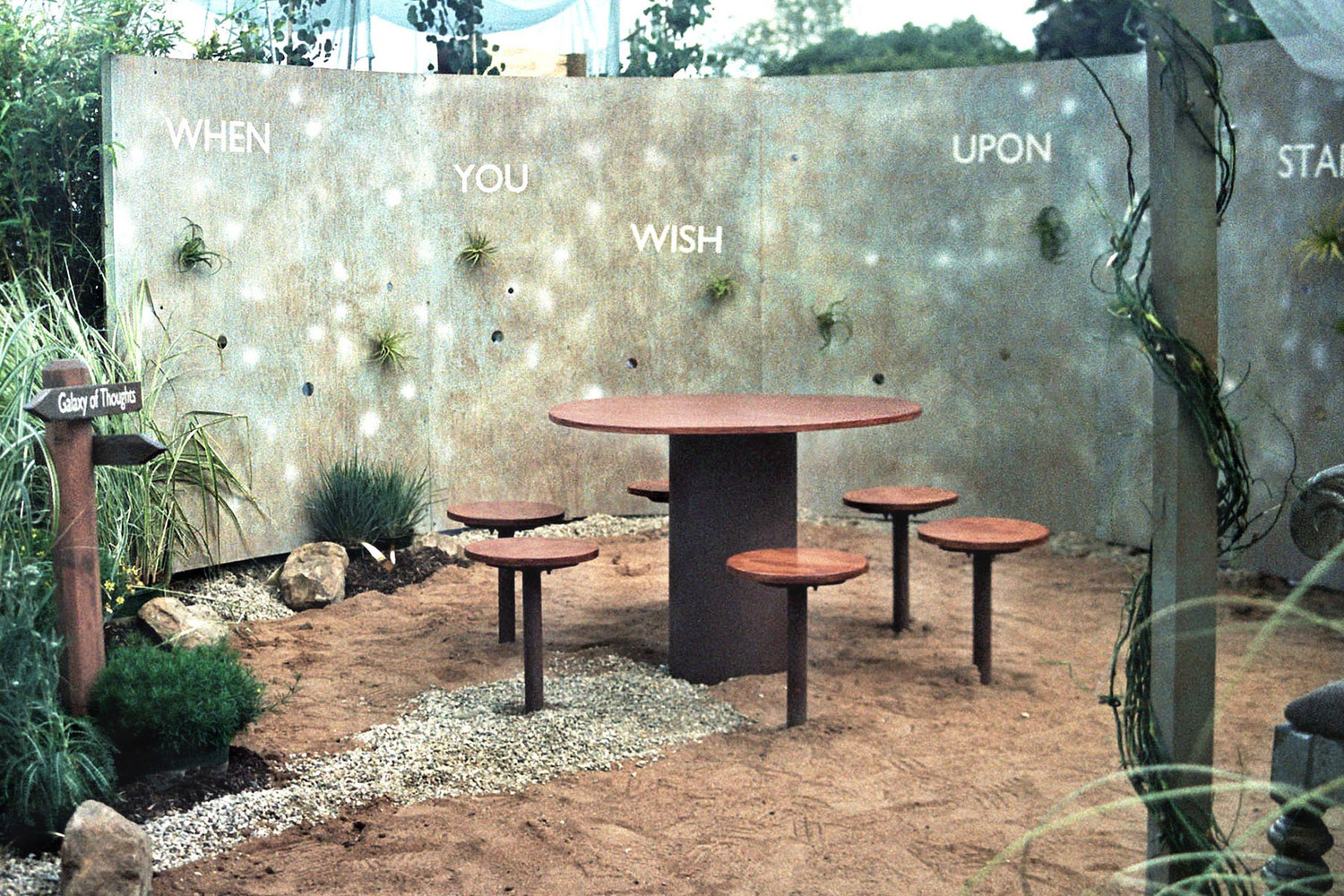
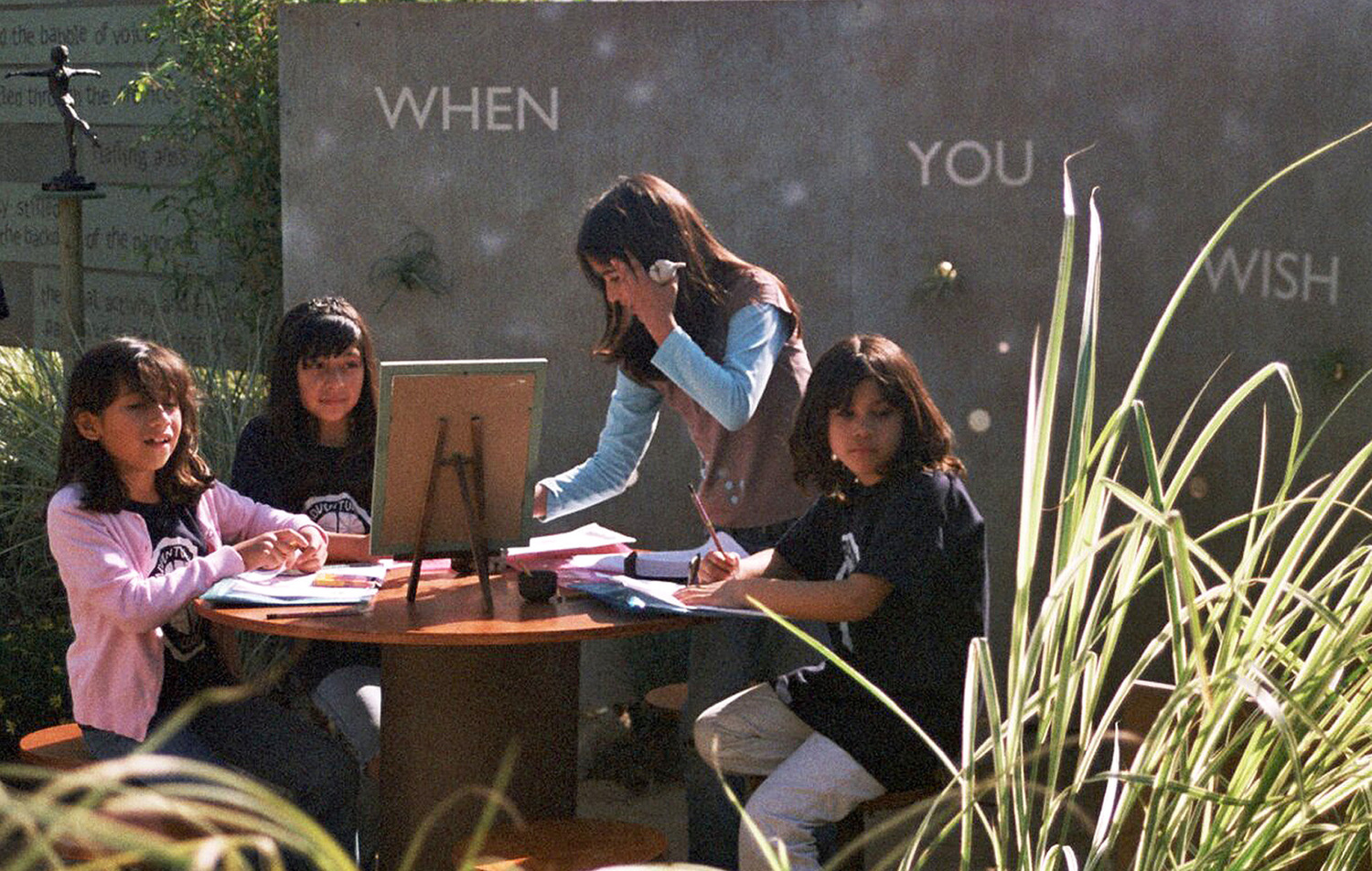

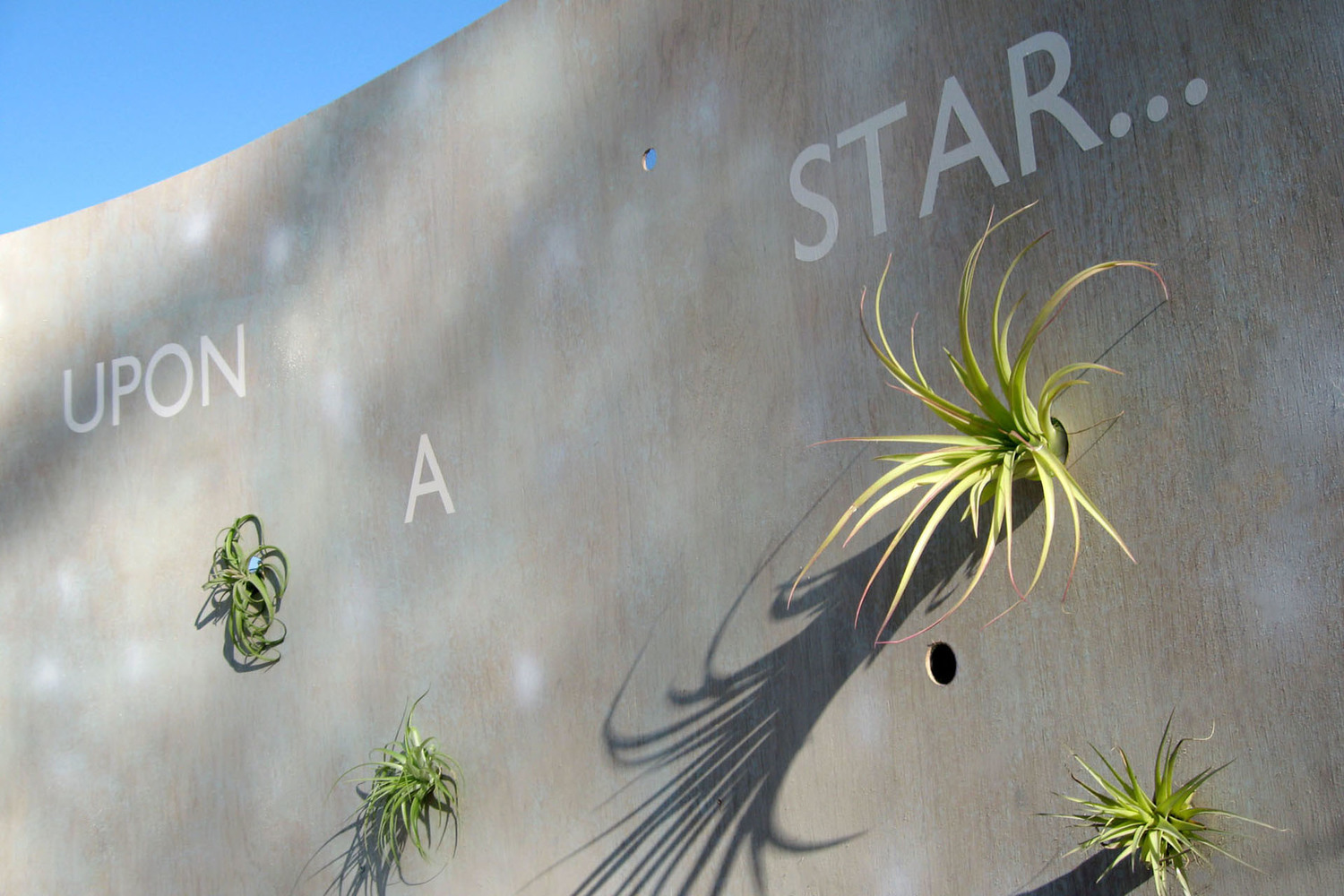
Photos courtesy of Ashley Elizabeth Ford.
HANNA FENICHEL GARDEN CLASSROOM
by Anne-Emilie Gold
Gravel To Gold, Inc., San Diego, CA
The playground is nestled under a mature Brazilian pepper tree providing shade and an undeniable connection to nature. Existing sculptural elements by local artist Betsy K. Schulz were integrated in the new design.
This Garden Classroom is serenely shaded by a bountiful pepper tree and constructed of repurposed building materials. The area is primarily focused on providing children with a natural environment for collaborative exploration of nature. Abundant raw materials (such as stones, sticks and pinecones), along with other loose parts and compostables are examples of the organic composition that makes the Garden Classroom such a special place for exploration and discovery. Here, children are encouraged to work together, imploring their imaginations to discover the world's physical elements. Examples of discovery include children working in the mud kitchen, maintaining the raised garden beds, bird and lizard watching, examining insects through microscopes, and much more. Our explorations are deepened by plenty of books and music.
Anne-Emilee Gold, in collaboration with Island Construction. designed this playground based on The Carnival of the Animals: a musical suite by the French Romantic composer Camille Saint-Saëns. Play elements refer to different musical movements of the suite such as “The Elephant”, “Tortoises”, or “The Cuckoo's Nest”.
Click images to enlarge.
by Arleen Ferrara
Satori Garden Design, Santa Monica, CA
THERAPEUTIC GARDEN LEARNING
When I began volunteering at Vista Del Mar Child and Family Services, I had no idea that I would get the opportunity to create not one, but two large therapeutic and edible gardens. In the fall of 2013, I had just completed my coursework for a Horticultural Therapy certification, but I needed to secure an internship where I could put in 480 hours as part of becoming registered in the field.
I had spent a fair amount of time gardening with children at my own children’s schools and I saw first-hand how helpful a garden environment was for kids struggling with challenges. Knowing that I wanted to work with the special needs population in a school setting, I began to look at satellite images of such schools within traveling distance that seemed to have enough outdoor space to accommodate a garden.
I felt like I hit the jackpot when I found Vista Del Mar, which has a 22 acre campus situated on the border of Cheviot Hills and Culver City. In short order, I was set up to help one of the teachers run a high school gardening program in a humble and weed-infested section of an old lawn—we spent more time weeding than growing food. As a landscape designer, I couldn’t help but ruminate over many ways our garden space could be improved and increased. What I ultimately proposed was a totally new garden with 15 raised beds, a native section, a small orchard, compost bins, habitat supporting plantings and a meeting area with shade. The proposed site would include the footprint of our current sad little garden, some adjacent asphalt and more weedy lawn that served no purpose, totaling about 5,000 sq. ft.
We were very fortunate to get a donation through John Paul DeJoria’s Peace Love and Happiness Foundation to cover the cost of the new garden and to hire me as a part-time horticultural therapist. The universe was definitely telling me I was on the right path. The garden has been in place since the winter of 2015 and is a thriving program that serves kids from kindergarten through age 22. The students struggle with various intellectual and developmental disabilities with many kids having suffered trauma and abuse. These are students who often have quite disruptive behaviors or need a lot of direction in order to accomplish a task. These kids need to diffuse energy, gain a sense of proficiency and get outside. We maintain the gardens in their entirety, from pruning, weeding, adding compost tea, mulching—everything. I am proud to say that during the last year, we’ve begun to offer up our harvest in Vista’s own CSA program.
The garden program is meant to be therapeutic on many levels and help the students work on the following objectives.
Listening and attuning to environment
Impulse control — limiting verbal or physical interruptions and oppositional behavior
Following a short set of directions in proper sequence
Getting along with each other!
Observation and discernment — What is the season? What are we growing? How does that feel/taste/sound? What is ripe? What tool do I need?
In designing the garden space I had the following considerations in mind:
Enclosure — I wanted the garden to feel like an enclosed safe place. Our location right next to the parking lot was not only a safety concern but an aesthetic issue. A split rail fence and a long berm of California native plantings serve as the buffer between garden and asphalt.
Circulation — The 15 beds are laid out in a grid with plenty of space to circulate around them. The orchard/native area is much more organic in shape with a figure “8” pathway serving as the way to get around. As there is always some hand watering to do, compost chopping or just flower picking this is a great area to send a student who is having a challenging time working with the rest of the class. .
Beautification and respite — Working with this population takes a special person and my hat is off to the teachers and support staff who do it day in day out. I wanted to design a beautiful place where staff could come and just de-stress. In addition, therapists on-site often take the kids they are working with and meander through the gardens while they are talking which beats sitting in an office any day. In planning the garden, I used plants that have aromatic leaves, attract wildlife with flowers or berries and provide a long season of bloom.
Thoughtful Storage — A place for lots of tools and classroom supplies was vital.
The “Peace, Love and Happiness” garden has been a huge success. In fact, it inspired another even larger donation to build a second garden outside of the residential unit of Vista Del Mar where adolescents live. This newer garden was installed in the summer of 2016 and was funded by the Francesconi-Tisch Charitable Fund and is called “Katia’s Garden.” This garden was developed in the 8,000 square feet of weedy lawn adjacent to the residence where we were able to capture rain from 9,000 square feet of roof to channel into two rain gardens.
Now we at Vista have what you might call an embarrassment of riches in the garden department. On any given day, you might find the students and I building a scarecrow or propagating plants, but it’s much more likely we are getting our hands dirty, tending to our own little paradise.
Photo courtesy of Grace Design Associates, Inc./Holly Lepere.
News and Events from the APLD Bay Area District
Upcoming Events:
APLD Bay Area Designer PLANT FAIR
If you are a plant geek, you’ll want to be at this event! The 2017 & 2018 APLD Designer Plant Fairs were a huge success, with over 100 attendees, more than a dozen dowers and nurseries presenting new plants, and so many giveaways! This year, the space will be twice as large with even more growers and nurseries, more food & drink, and more time to soak it all in!
Tuesday, August 13, 2019 from 3-7pm
at the Lafayette Veterans Memorial Building
More Info Here
Click to zoom.
APLD Bay Area PANEL DISCUSSION
BEYOND DESIGN ONLY:
DIVERSIFYING FOR A WELL-ROUNDED BUSINESS
Join us for this informative panel discussion with experienced APLD landscape designers who will share their strategies for balancing their time and income between landscape design and other related services such as: aesthetic pruning, maintenance, seasonal maintenance reviews, express or on-site garden design, irrigation design & troubleshooting, nursery work, container garden design/installation, teaching/public speaking, garden writing, garden coaching, site measuring & base sheet preparation, CAD & SketchUp services, water budgeting & MWELO calculations, lighting and water feature design, garden photography, and more!
Wednesday, August 28, 2019 from 3-5pm
at The Gamble Garden
1431 Waverley Street, Palo Alto, CA
More Info Here
Click to zoom.
APLD Bay Area Special event
AUTUMN CELEBRATION AT THE UC BOTANICAL GARDEN
Learn about amazing plants from the UC Botanical Garden plant experts. Meander through the spectacular gardens while mingling and networking with landscape designers, contractors, horticulturists, and landscape industry leaders from all over California.
Tuesday, September 10, 2019 from 5-8pm
at the UC Botanical Garden
200 Centennial Drive, Berkeley, CA
More Info Here
Click to zoom.
APLD Bay Area Speaker Series
the professional designer’s guide to garden furnishings with vanessa garner nagel, fapld
Gardens don’t need just plants, paths, and walls; they need carefully chosen accessories and furnishings. Vanessa will share her insights on how furnishings are linked to architecture; she will offer tips and techniques for choosing furnishings based on comfort, scale, and proportion. She will also discuss the properties of a wide variety of material choices including wood, stone, ceramics, concrete, metal, and fabrics.
Wednesday, September 25, 2019 from 3-5pm
at Gamble Garden, Palo Alto
More Info Here
Click to zoom.
APLD Bay Area SPEAKER SERIES
the best trees for small bay area gardens with laura forlin
Not all trees are created equal…especially when it comes to challenging urban conditions: small spaces with close proximity to buildings and less-than-perfect soils. But with years of study and practical experience, landscape designer, lecturer, and arborist Laura Forlin will share with us the best performing trees for small urban landscapes.
Tuesday, October 8, 2019 from 4-6pm
at the Lafayette Veterans Memorial Building
More Info Here
Click to zoom.
APLD Bay Area designer forum
MWELO HEADACHES AND HICCUPS
Join us for a roundtable discussion about the challenges of designing a project that is subject tot he Model Water Efficient Landscape Ordinance compliance.
Wednesday, October 23, 2019 from 3-5pm
at Gamble Garden, Palo Alto
More Info Here
Click to zoom.
News & Events from the Sacramento District
UPCOMING EVENTS:
THE APLD DESIGNER DIRT WORKSHOP
Designer Dirt Sessions are your chance to talk dirt about our industry with other designers. A moderator will lead this small group discussion on topics of interest specific to being a local designer. Ever wondered how other designers deal with the “Problem Client”? Any hot tips to increase profits? Are there water-wise water features? Favorite new plant? Where do you find inspiration? Bring your own topics as well and be prepared to talk dirt!
Bonus: Show & Tell: Bring photos of a cool project, plant pairing, site amenity or what not to share. Curious how other designers might tackle a current project? Bring photos or a plan for input.
You are encouraged to invite non-APLD members as long as they are design focused.
APLD Members: Free, Non-Members: $10
Purchase your own food and drink at the counter.
Thursday, July18, 2019 from 6-8pm
Ettore’s Restaurant & European Bakery
2376 Fair Oaks Blvd, Sacramento 95825
RSVP to Gary Kernick at sacprograms@apldca.org or call 916 835 6920
Welcome New Members
Please give a warm welcome to these new members of the APLD California Chapter.
Qualified Professional Members
An individual who is a landscape designer and has more than three years of professional landscape design experience. Membership requires documentation of education and experience.
Carola Fiore
Crear Landscape Design, San Diego, CA
Srvidya Krishnan
Fill Good Horticulture, LLC, Diamond Bar, CA
Emerging Professional Members
An individual who has been practicing landscape design for one to three years and is starting a career in landscape design. Membership requires affirmation of education and experience, but not documentation.
Chelsea Chan
David Thorne Landscape Architect, Inc, Oakland, CA
Kelly LeVoir
Encinal Nursery, Alameda, CA
Olga Dobrowolska
Artistic Garden Designs, Cotati, CA
David Meirik
MD Landscapes, Santa Rosa, CA
Student Members
An individual who is actively enrolled, on a full or part‐time basis, in a landscape design, landscape architecture or horticulture program. Membership is limited to five years of membership at this level and proof of enrollment must be submitted.
David Cruz Martinez, Oceanside, CA
Jennifer Bromme, Pacifica, CA
Karly Silicani, Walnut Creek, CA
Kirby Baldacci, Oakland, CA
Photo courtesy of Patricia St. John, FAPLD.
APLD California Chapter
Sponsors
Through sponsorship of APLD California Chapter, these industry leaders declare their support for best practices, educational programs and events, and the highest standards in landscape design. From veteran materials suppliers to producers of cutting-edge landscape products, these companies have committed to connecting with professional landscape designers and our clients.
SPONSOR TOOLS AND TIPS:
How to make a good lighting job great:
Observations from a CLCA beautification lighting judge
by Bruce Dennis of Lightcraft Outdoor, an APLD CA Bronze Sponsor
Recently, I had the pleasure of being a residential landscape lighting judge for the California Landscape Contractors Association (CLCA) 61st Annual Beautification Awards. There were 12 competing landscape contractors from the Orange County Chapter who submitted their jobs for various awards. The locations ranged from upper end Newport Beach to medium level Cypress, Calif. The lighting awards were graded on several factors and separated by the number of fixtures used on the project (under 35, 36-80 and 81 or more fixtures). The awards ranged from Overall Brilliance, 1st and 2nd place.
The criteria were ranked on the following:
•Effects- Dramatic, Combined and Special
•Installation- Fixture Selection, Proper Use of Beam Spread, Voltage Drop, Mountings, Color Rendition, Controllers and Safety.
The reviews lasted two full nights from 6:30 pm to 12:00 am. The CLCA provided a van, a driver, a navigator and a photographer for two lighting judges. The judges were (myself) Bruce Dennis from Lightcraft Outdoor and David Oborn from FX Luminaire. We reviewed 6 projects per night. It was a challenge as the homeowners not only needed to give their permission but needed to be home and allow access to the outdoor space. The additional challenge was that many of the homes were in gated and private communities so the guard gates had to be aware of our intention, especially toward the end of the night. Luckily, there were no dogs or other pets to worry about. At the end of the night the votes were tallied based upon the factors listed above. Interestingly enough, both David and I had very similar comments per project and were mostly in sync on what was good, what could have been better and what could have been considered poor lighting choices.
Positive notes from the two nights:
•Most of the jobs had good “balance” where the property had good lighting throughout the yard.
•Most of the jobs had appropriate light levels and were not overly lit and primarily used warm kelvin colors (2700k and 3000k).
•Most of the jobs hid the cable and the transformers were out of sight.
•Most of the jobs used brass and high quality materials.
•Most of the jobs used high quality replace-able/service-able drop in LED lamps.
•Some of the contractors had well thought out wiring systems (pre wired) where individual, large decorative pots were nicely lit that were sitting on exquisite flooring.
Improvement notes from the two nights:
•Glare was an issue on most of the projects. This could have easily been resolved with a night review with simple adjustments and location placement.
•Most of the stairs were under lit. This is a potential hazard.
•Many of the properties had “voids” of light. This is unpleasant to the eye when viewing at certain perspectives.
•Many of the “voids” were due to unlit trees that fell on the other side of the property or fence line. It would have looked much better to incorporate the trees and specimens that can be seen as part of a balanced lighting plan, even though they were not directly on the property. Other “voids” were simply due to not enough fixtures.
•Most of the jobs used up lights, but many did not incorporate enough “small wash lights” for the shrubs and bushes. Wash lights provide soft and great low level light and are ideal for small specimens and short pony walls. Wash lights are also great “fillers” to balance the lighting pallet.
•The light levels could have been more creative with less wattage (lumens) in front, medium light levels in the middle and more wattage (lumens) in the back of the property.
In conclusion, I was excited to see how lighting has become such an integral part of professional landscape projects. Landscape lighting provides beauty and enhances the overall landscape plan. Lighting also provides safety and security which is incredibly important. The projects that we reviewed all had high levels of owner satisfaction, which in itself is a great success. We all know that “landscape lighting can be more of an “art than a science”. It is critical for the contractor to review the lighting at all stages of the installation, especially at night. Finally, the difference between a good lighting job and a great lighting job can be just a matter of inches (placement, direction and shielding).
For more information please contact brucedennis@sbcglobal.net
OUR PLATINUM SPONSOR:
Bay Scenery specializes in delivering high-quality landscape construction services in and around Silicon Valley. Through the acquisition of well-known companies such as Harris Landscaping Company, we have cultivated a reputation for excellence in landscape construction for over 30 years.
OUR GOLD SPONSORS:
Simply click on a logo below to visit the website of one of our sponsors.
OUR SILVER SPONSORS:
OUR BRONZE SPONSORS:
Please contact Julie Molinare at sponsorship@apldca.org
Photo courtesy of Mary Fisher, FAPLD.
Opportunities and Events
APLD or APLD Sponsor events in BOLD.
JULY
25th Annual Sculpture in the Garden Show at Ruth Bancroft Garden
Walnut Creek, CA
June 30-September 1
Right Plant, Right Place with Lili Singer at Theodore Payne Foundation
Sun Valley, CA
July 6, 2019
Building Resilience with Native Plants: Gardening for Wildlife with Erin Johnson
Los Angeles, CA
July 10, 2019
G3 California Friendly and Native Plant Landscaping Class hosted by LA Department of Water and Power
Van Nuys, CA
July 13, 2019
G3 Turf Removal and Garden Transformation Workshop hosted by the City of Oxnard
July 13, 2019
Three-Part CA Native Garden Design with Carlos Flores at Theodore Payne Foundation
Sun Valley, CA
July 13, July 27, & August 10, 2019
Greywater: Laundry to Landscape class with Alan Hackler at Lyngso, an APLD CA Gold Sponsor
San Carlos, CA
July 13, 2019
Urban Homestead Tour
Pasadena, CA
July 14, 2019
California Horticultural Society Lecture: Iris of the Caucasus & Eastern Mediterranean
San Francisco, CA
July 15, 2019
G3 Turf Removal and Garden Transformation Workshop hosted by West Basin MWD
Inglewood, CA
July 16, 2019
The APLD Designer Dirt Workshop
Sacramento, CA
July 18, 2019
RSVP to sacprograms@apldca.org
Walking Tour: Weeds in the Urban Landscape with Richard Orlando at Mills College
Oakland, CA
July 20, 2019
G3 California Friendly and Native Plant Landscaping Training Class hosted by City of San Juan Capistrano
July 20, 2019
Three-Part CA Native Garden Design with Steve Gerischer at Theodore Payne Foundation
Sun Valley, CA
July 20, August 3, & August 17, 2019
The Good, The Bad, The Ugly – Garden Bugs class with Diego Torrelio at Lyngso, an APLD CA Gold Sponsor
San Carlos, CA
July 20, 2019
Rain Bird Academy Boot Camp
San Diego, CA
July 22-26, 2019
G3 California Friendly and Native Plant Landscaping Class hosted by LA Dept of Water and Power
Los Angeles, CA
July 27, 2019
WaterSmart Workshop: Nurturing Your WaterSmart Garden’s Health with ReScape CA
Citrus Heights, CA
July 27, 2019
APLD International Design Conference
Seattle, WA
July 25-29, 2019
G3 California Friendly and Native Plant Landscaping Class hosted The City of Santa Ana
July 31, 2019
G3 Turf Removal and Garden Transformation workshop hosted by the Upper San Gabriel MWD and Valley County WD
Baldwin Park, CA
July 31, 2019
AUGUST
Insect Apocalypse? Is insect Biodiversity and Biomass Declining? A lecture with CNPS Yerba Buena Chapter
San Francisco, CA
August 1, 2019
Travels with Brian & Walker – Ethiopia Edition at Ruth Bancroft Garden
Walnut Creek, CA
August 8, 2019
Nursery/Landscape Expo 2019
San Antonio, Texas
August 8-10, 2019
G3 California Friendly and Native Plant Landscaping Class hosted by LA Dept of Water and Power
Van Nuys, CA
August 10, 2019
Permaculture Principles class with Alan Hackler at Lyngso, an APLD CA Gold Sponsor
San Carlos, CA
August 10, 2019
Right Plant, Right Place with Lili Singer at Theodore Payne Foundation
Sun Valley, CA
August 10, 2019
Rain Bird Academy Boot Camp
Palm Desert, CA
August 12-16, 2019
The 3rd Annual APLD Bay Area Designer Plant Fair
Lafayette, CA
August 13, 2019
Greywater Installer’s Course
Los Angeles, CA
August 14-18, 2019
G3 California Friendly and Native Plant Landscaping Class hosted by Camrosa WD and Calleguas MWD
Camarillo, CA
August 17, 2019
Rescape CA Speaker Series: Healthy Soil Sequesters Carbon
Sacramento, CA
August 22, 2019
Farwest Trade Show
Portland, OR
August 21-23, 2019
G3 California Friendly and Native Plant Landscaping Class by LA Dept of Water and Power
San Pedro, CA
August 24,2019
APLD Bay Area Panel Discussion: Beyond Design-Only at the Gamble Garden
Palo Alto, CA
August 28, 2019
G3 Turf Removal and Garden Transformation workshop hosted by the West Basin MWD
Hermosa Beach, CA
August 29, 2019
Three-Part CA Native Garden Design with Shawn Maestretti at Theodore Payne Foundation
Sun Valley, CA
August 31, September 14 & 28, 2019
SEPTEMBER
GardenComm Annual Conference & Expo
Salt Lake City, UT
September 4-7, 2019
APLD Bay Area Autumn Celebration at UC Botanical Garden
Berkeley, CA
September 10, 2019
Dry Gardens: High Style for Low Water Gardens with San Diego Horticulture Society
September 9, 2019
CA Friendly Landscaping Class
Oxnard, CA
September 14, 2019
Garden Conservancy Open Days
San Jose, CA
September 14, 2019
Building Resilience with Native Plants: Right Plant, Your Place with Lili Singer
Los Angeles, CA
September 17, 2019
Professional Designer’s Guide to Garden Furnishings, an APLD Bay Area presentation with Vanessa Gardner Nagel
Palo Alto, CA
September 25, 2019
Pacific Horticulture Society tour of Tuscany
September 28-October 5, 2019
OCTOBER
CA Garden & Landscape History Society Annual Conference
Lompoc, CA
October 4-6, 2019
The Best Trees for Small Bay Area Gardens, an APLD Bay Area Speaker Series with Laura Forlin
Lafayette, CA
October 8, 2019
UC Botanical Garden Symposium “Connecting Plants and People, An Ethnobotanical Conversation”
October 11-12, 2019
CA Friendly Landscaping Class
Oxnard, CA
October 12, 2019
Rain Bird Academy Boot Camp
Sacramento, CA
October 14-18, 2019
Rain Bird Academy Boot Camp
Bakersfield, CA
October 21-25, 2019
The 2019 Long Beach Landscape Expo
October 23-24, 2019
Dry Garden Design: The Continuing Legacy of the Ruth Bancroft Garden, a Horticultural Symposium
Walnut Creek, CA
October 26-27, 2019
MWELO Headaches & Hiccups, an APLD Bay Area Designer Forum
Palo Alto, CA
October 23, 2019
What’s Out There Weekend San Diego, tours with TCLF
October 26-27, 2019
NOVEMBER
Pacific Horticulture Society tour of Australia with Linda McKendry
November 5-19, 2019
G3 Watershed Wise Professional Certification
Sacramento, CA
November 7-8, 2019
Designing Custom Water Features, an APLD Bay Area Panel Discussion
Lafayette, CA
November 12, 2019
CLCA Annual Convention
Lake Tahoe
November 13-16, 2019
Building Resilience with Native Plants: Essentials of Native Plant Horticulture with Lili Singer
Los Angeles, CA
November 14, 2019
Icons of Modernism Excursion with The Cultural Landscape Foundation
Palm Springs, CA
November 14, 2019
ASLA Conference on Landscape Architecture
San Diego, CA
November 15-18, 2019
Walk the Talk Tours: The Invisible Structures of Permaculture
Fairfield, CA
November 16, 2019
CA Friendly Landscaping Class
Oxnard, CA
November 16, 2019
Cool Coloring Techniques, an APLD Bay Area Panel Demonstration at the Gamble Garden
Palo Alto, CA
November 20, 2019
DECEMBER
2019 Irrigation Show
Las Vegas, NW
December 2-6, 2019
Contributors to Summer 2019 Edition:
Content Coordinator: Mary Fisher, FAPLD
Design and Content Editor: Maggie J Elias
Call for Submissions
We invite your participation in the California Landscape Design magazine Fall 2019 edition with a theme of "Trees: The Star of the Garden". Please send your story ideas to newsletter@apldca.org before August 1, 2019.






